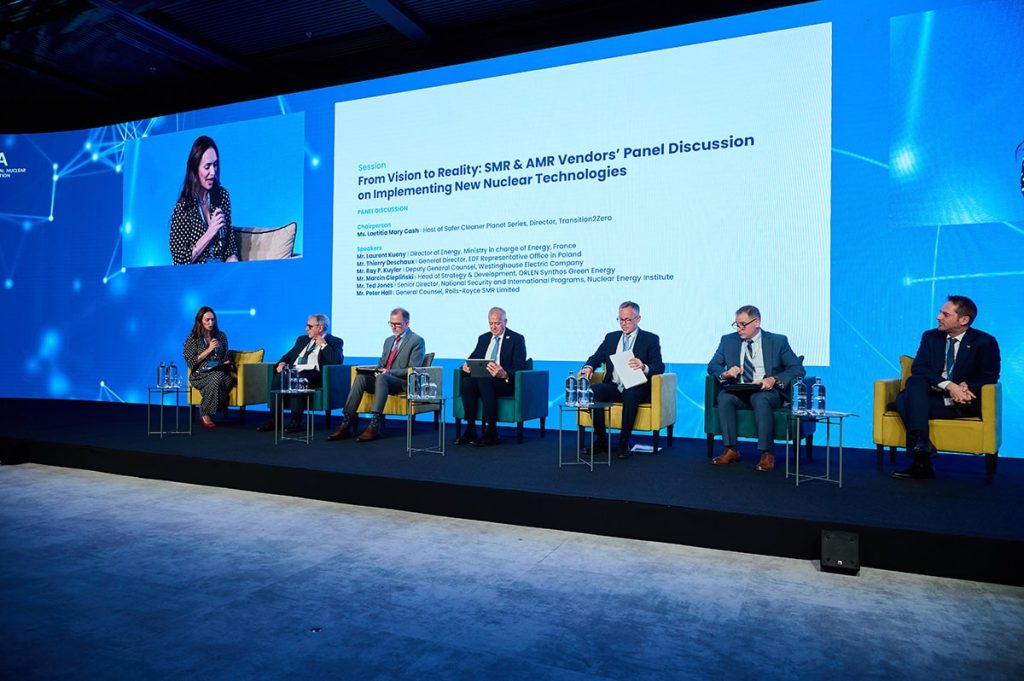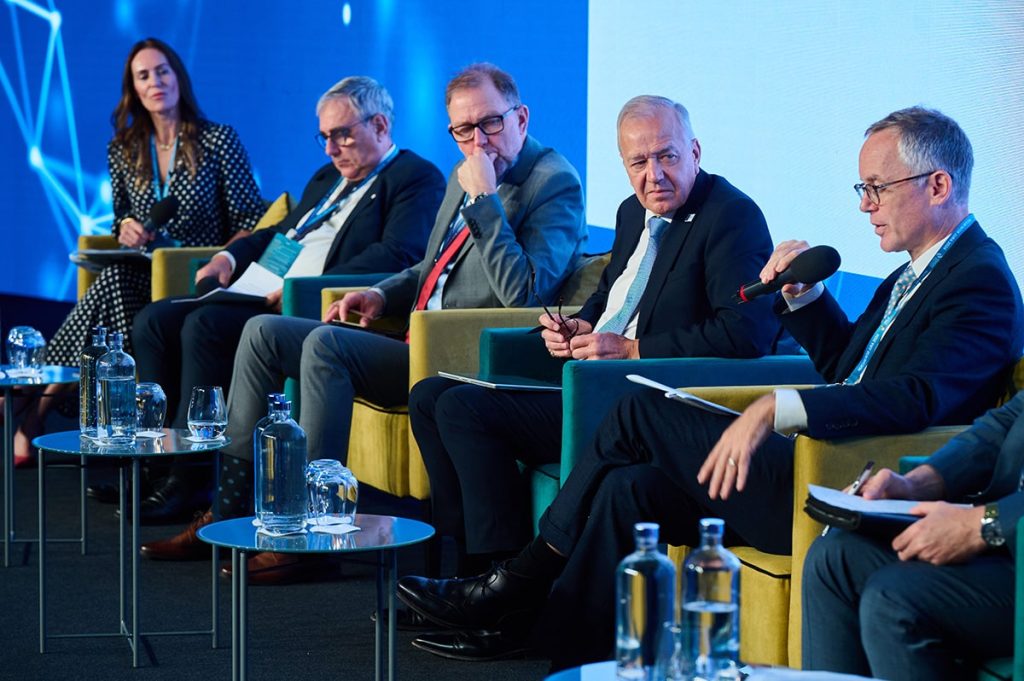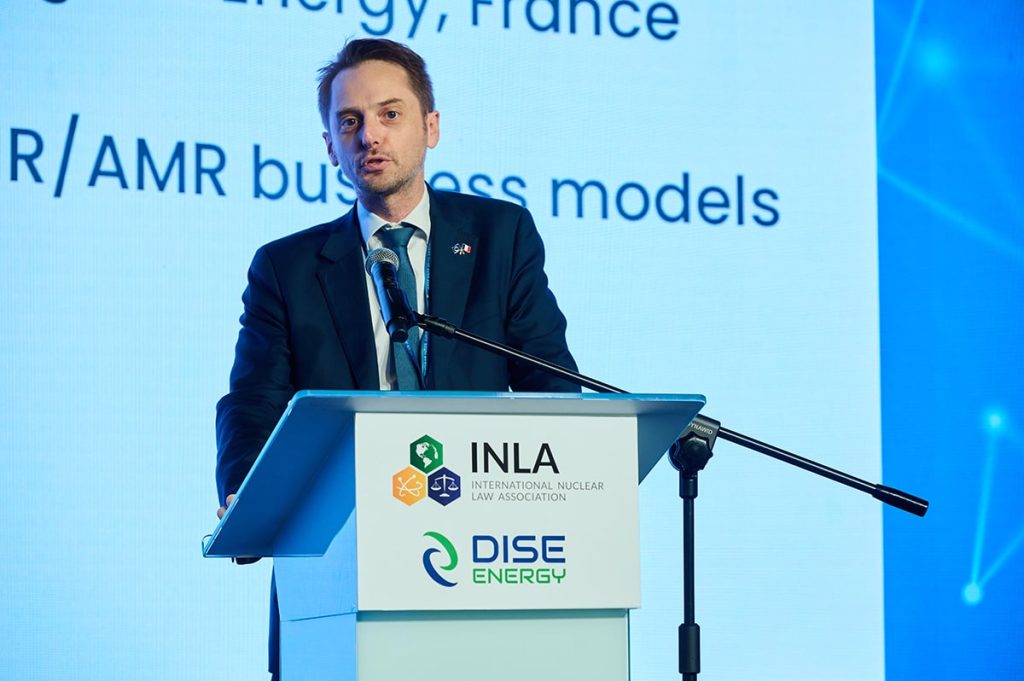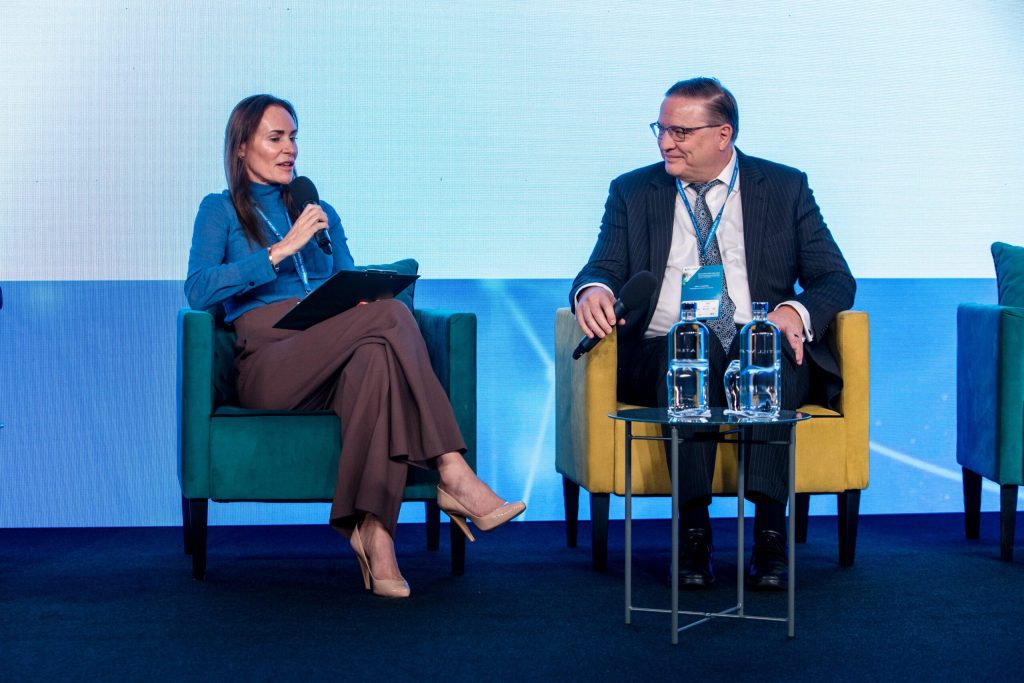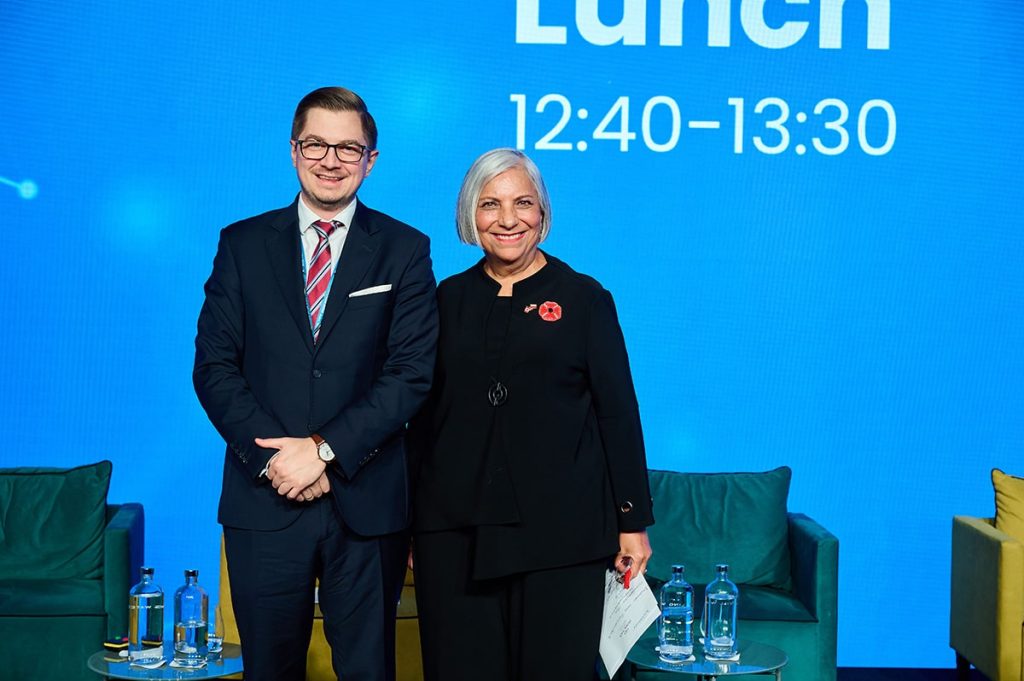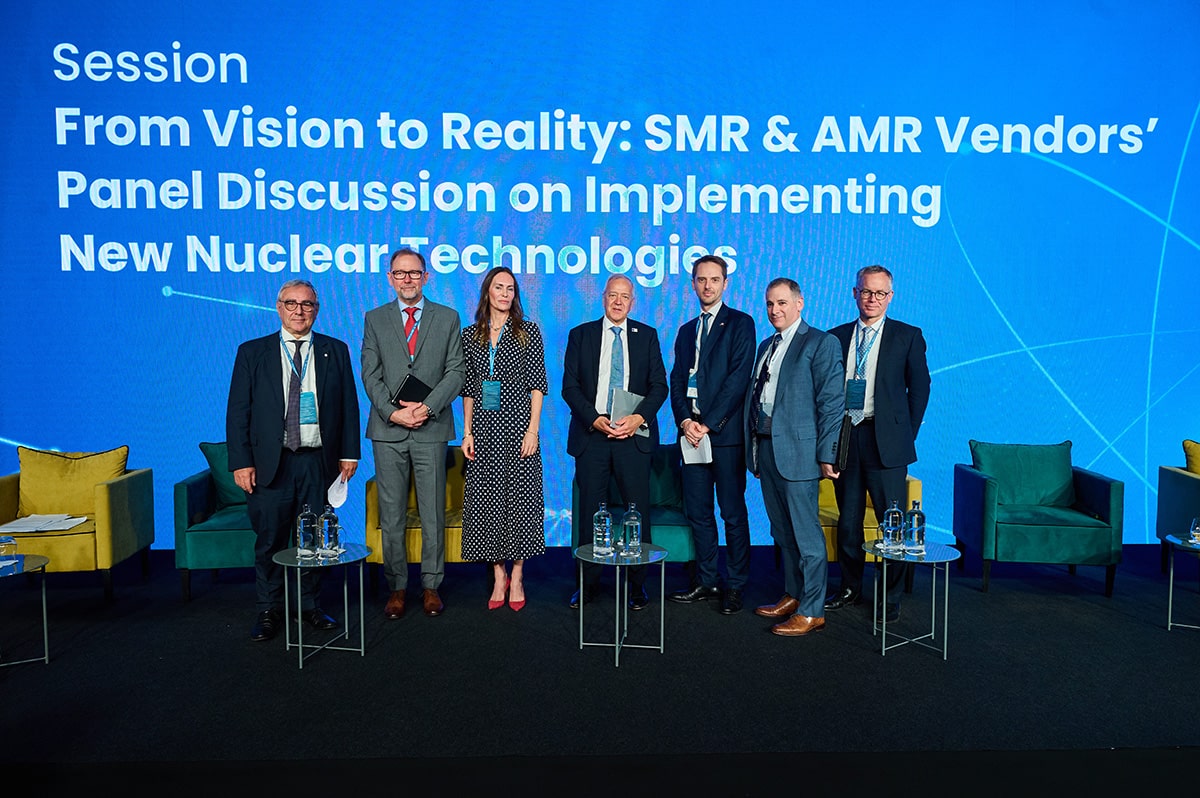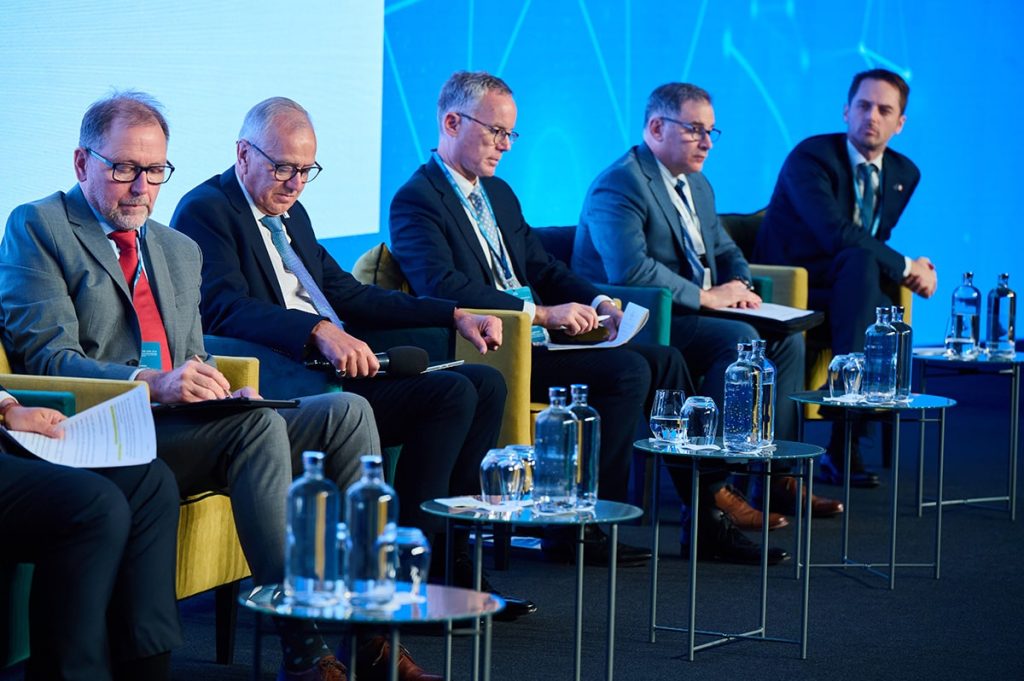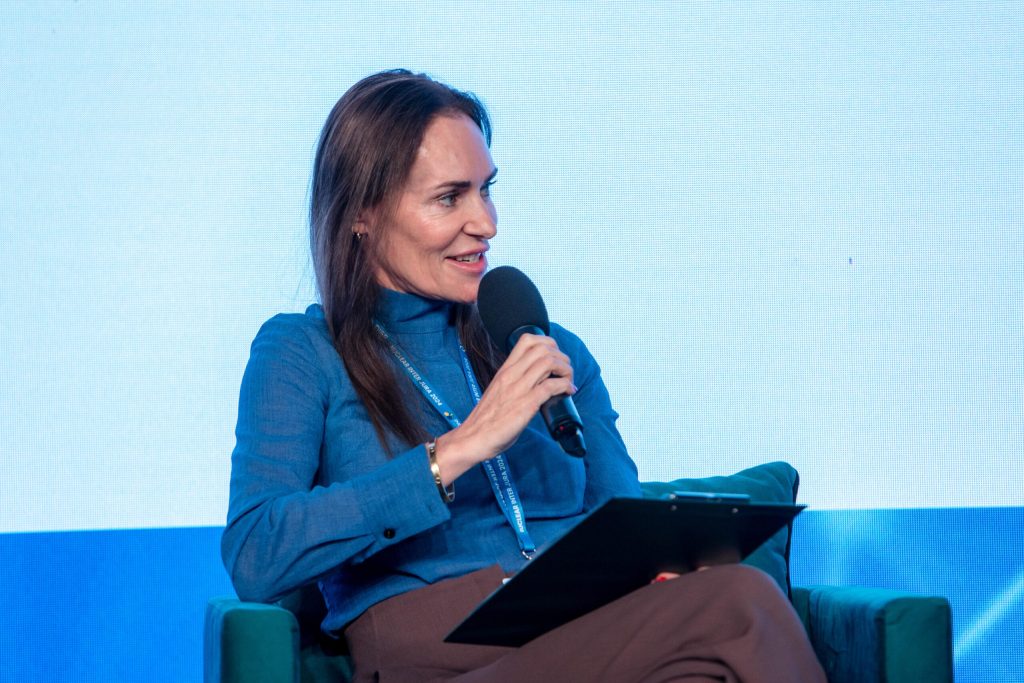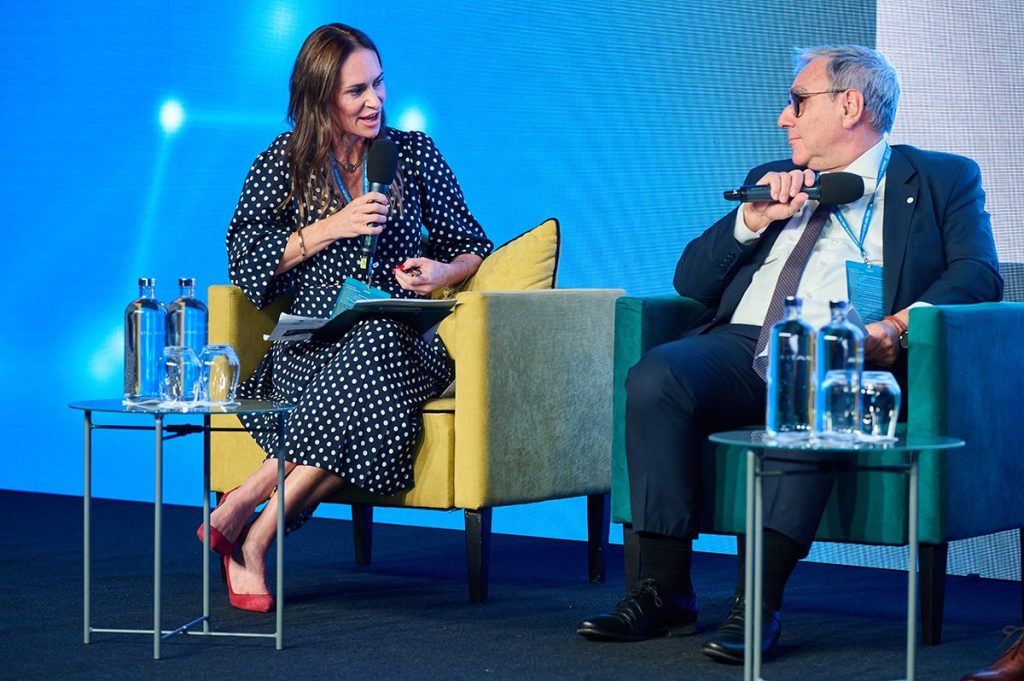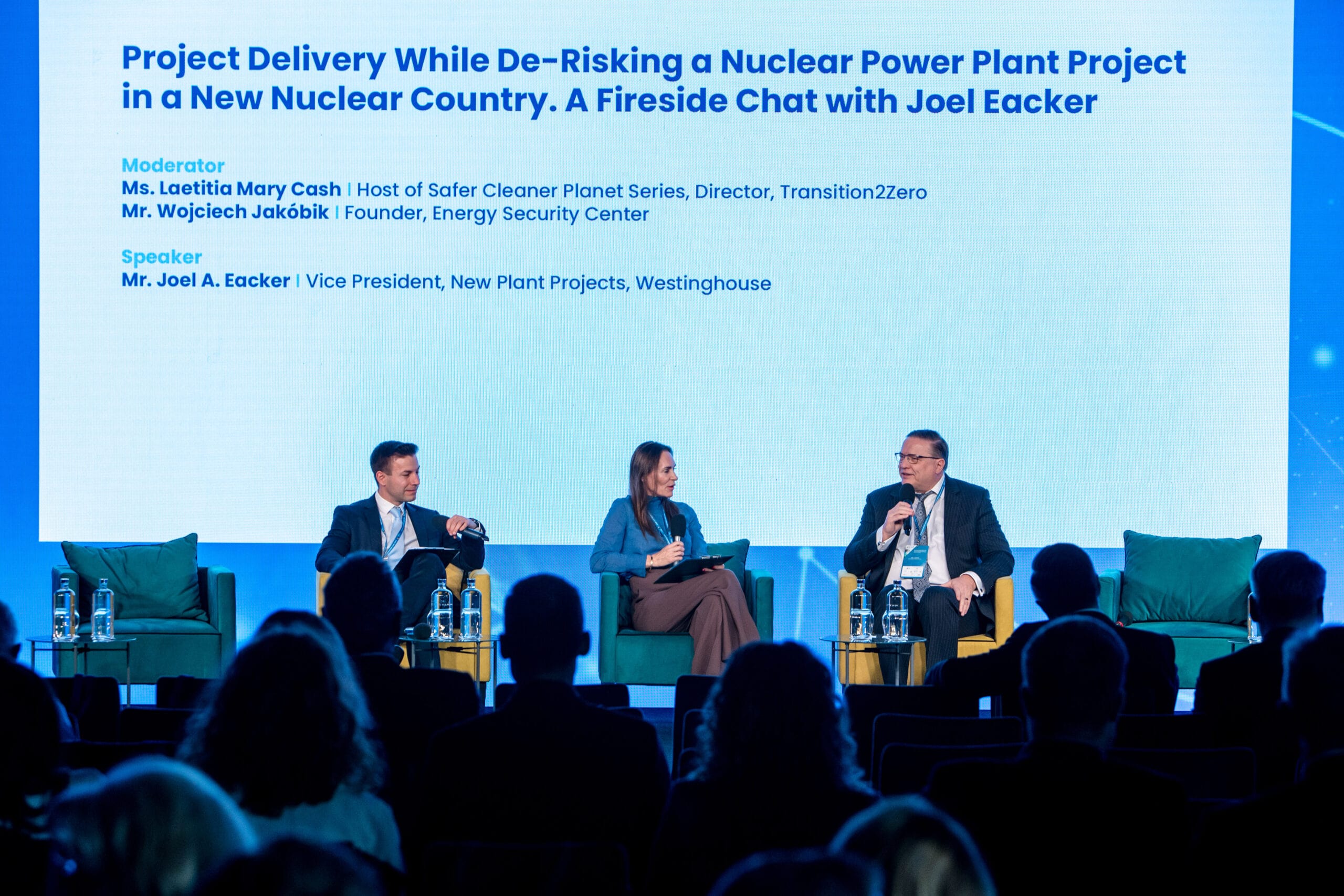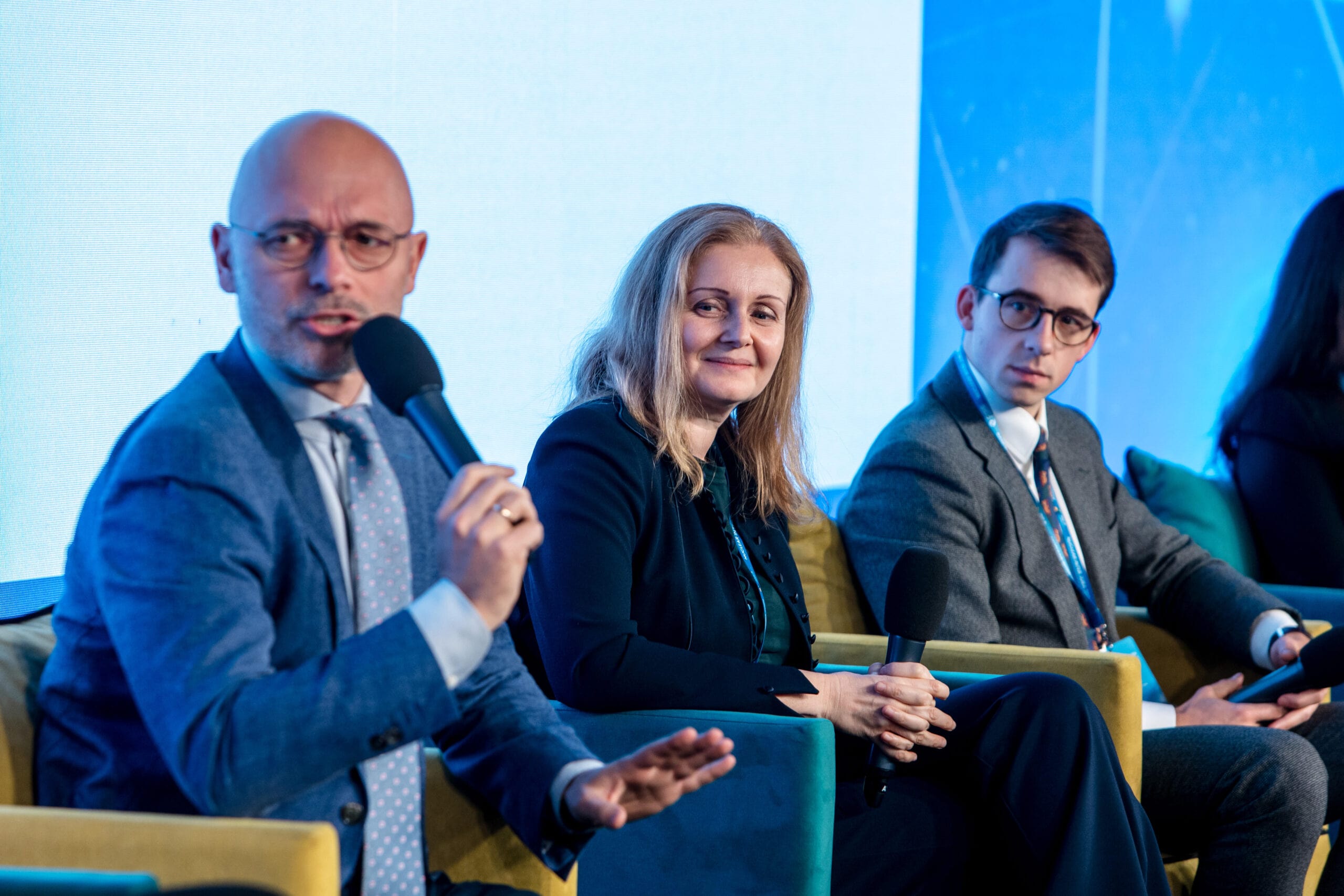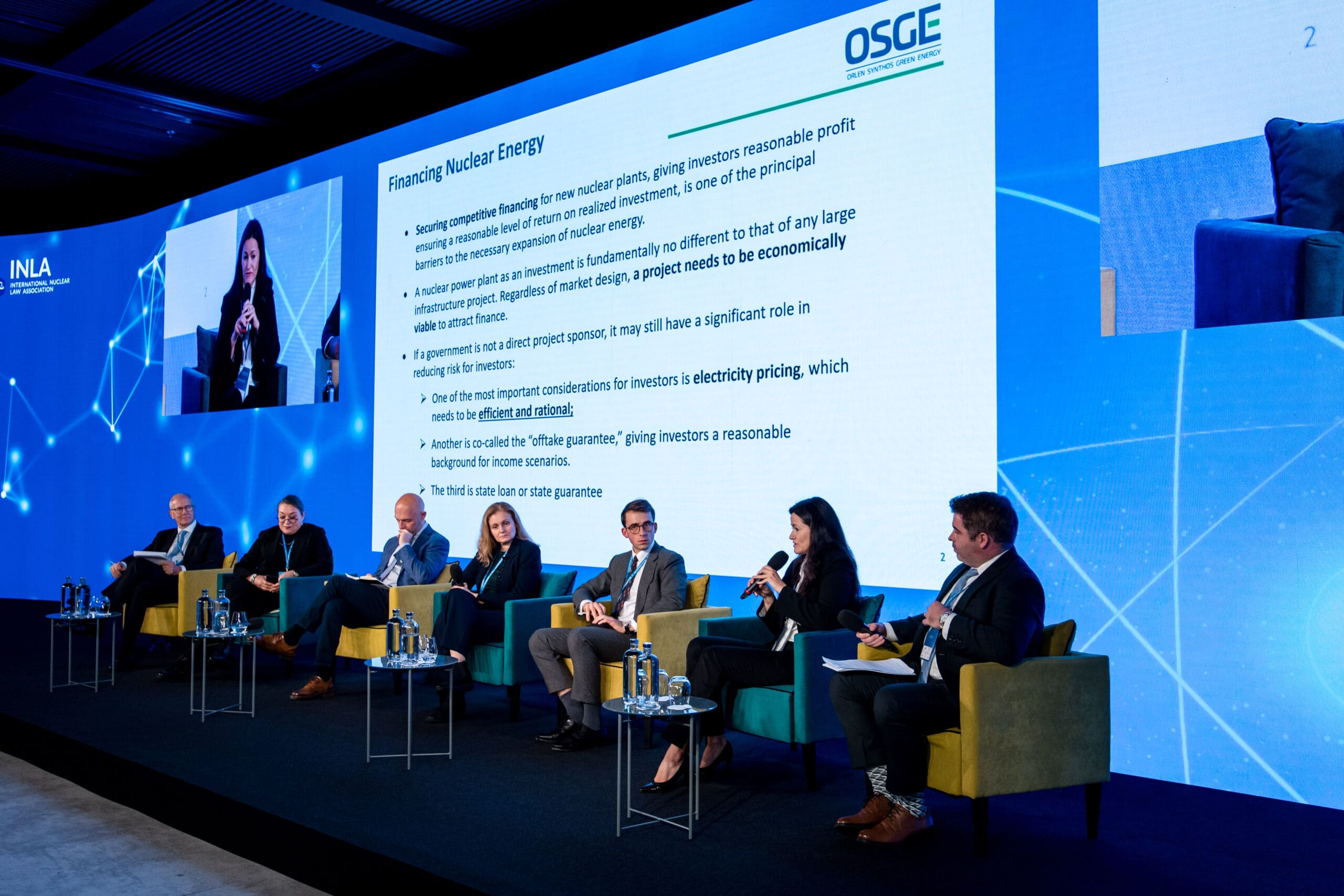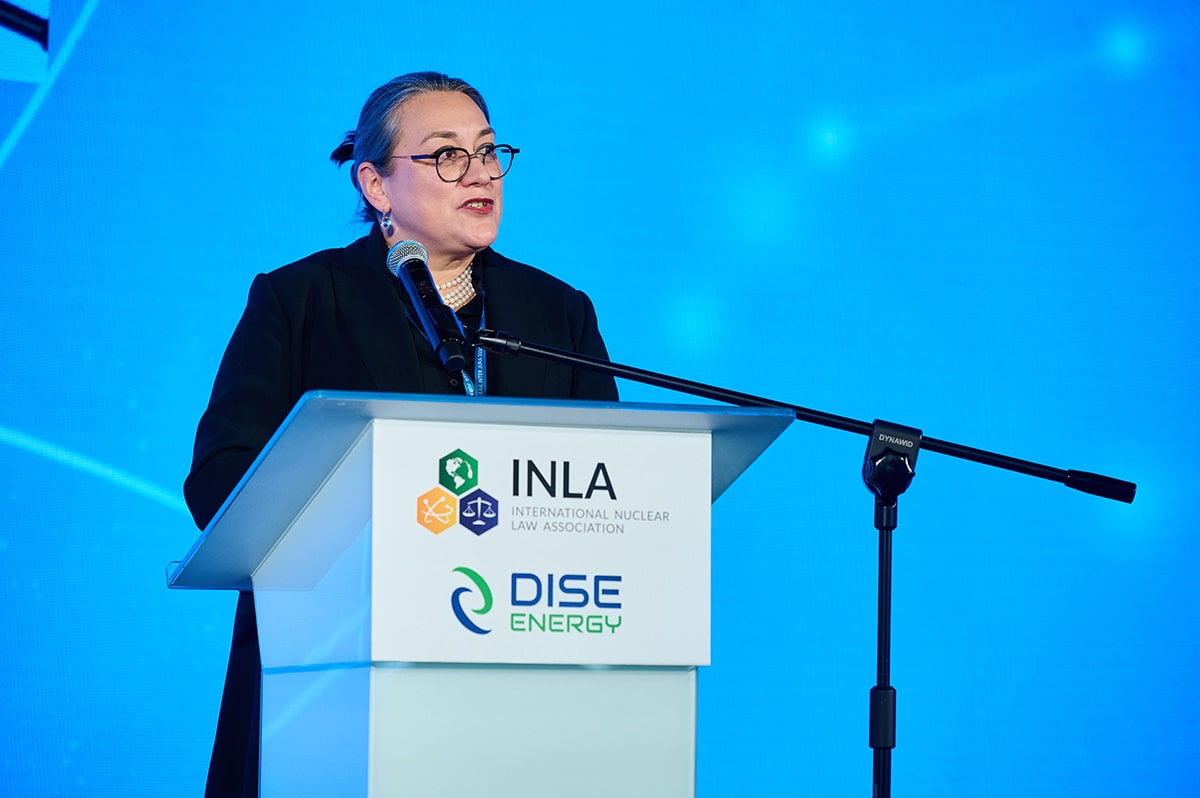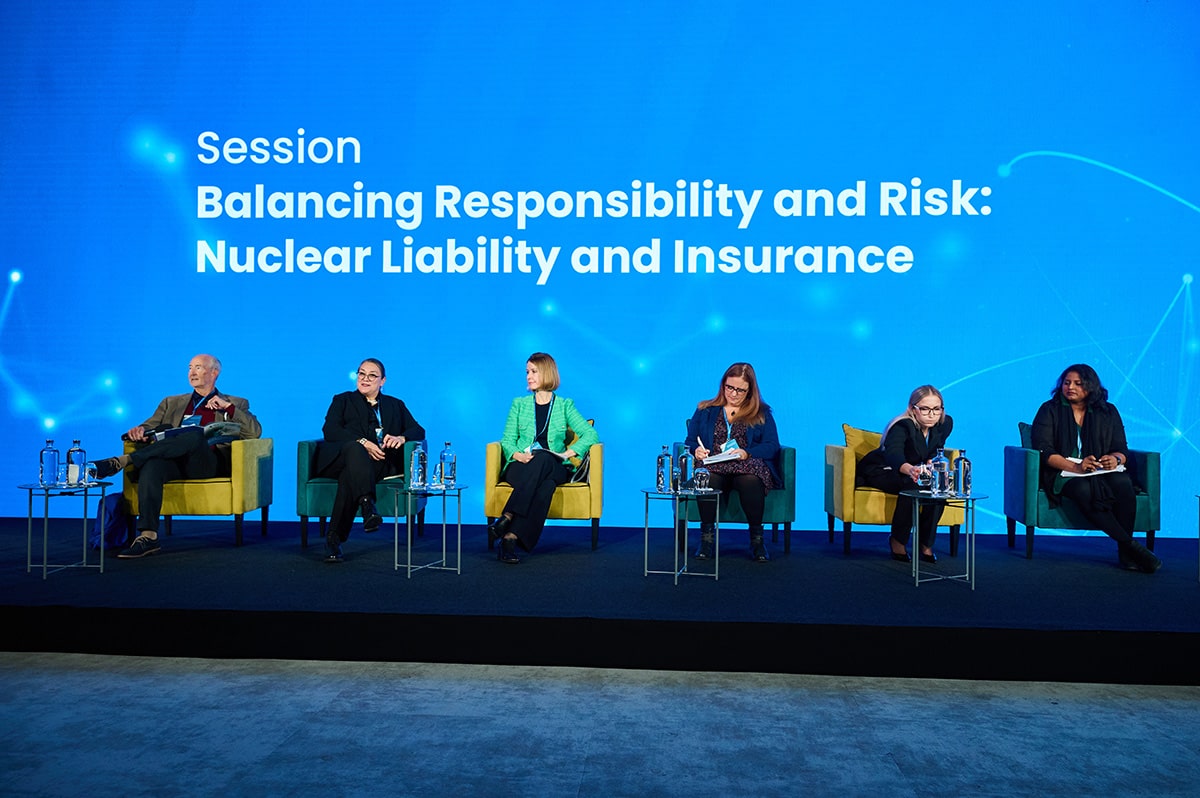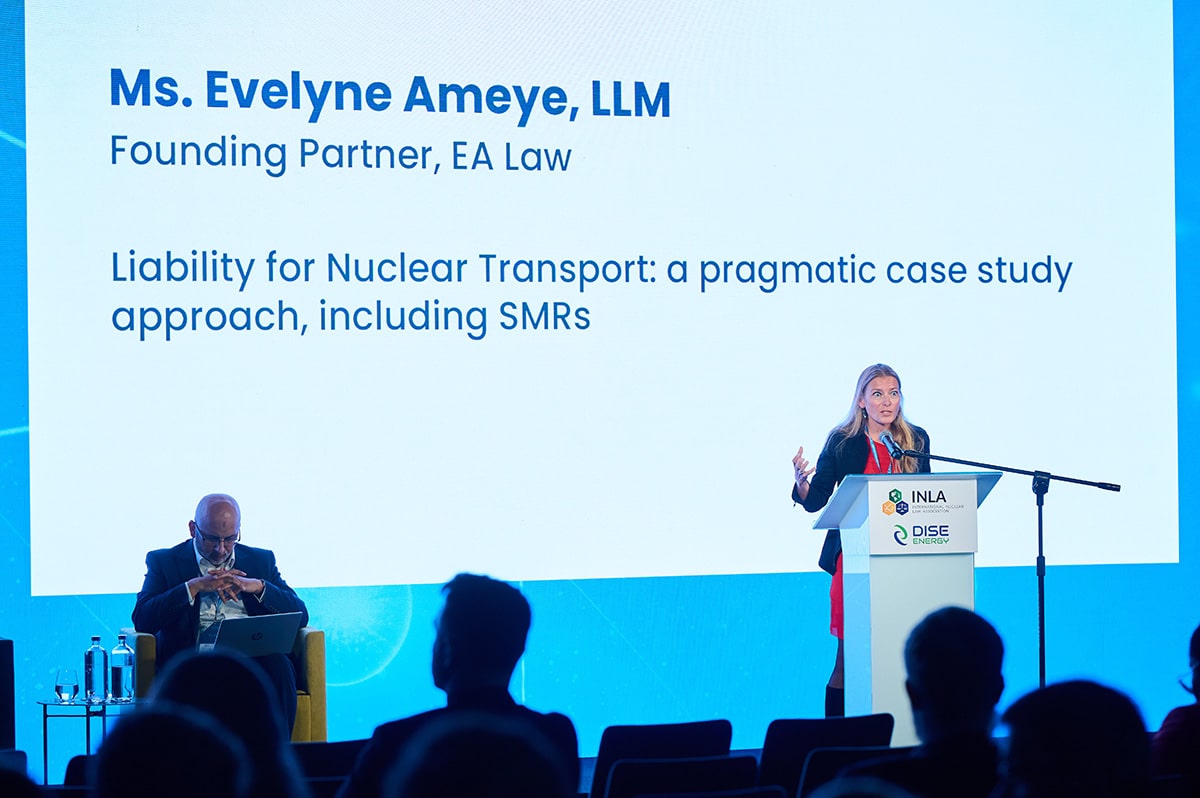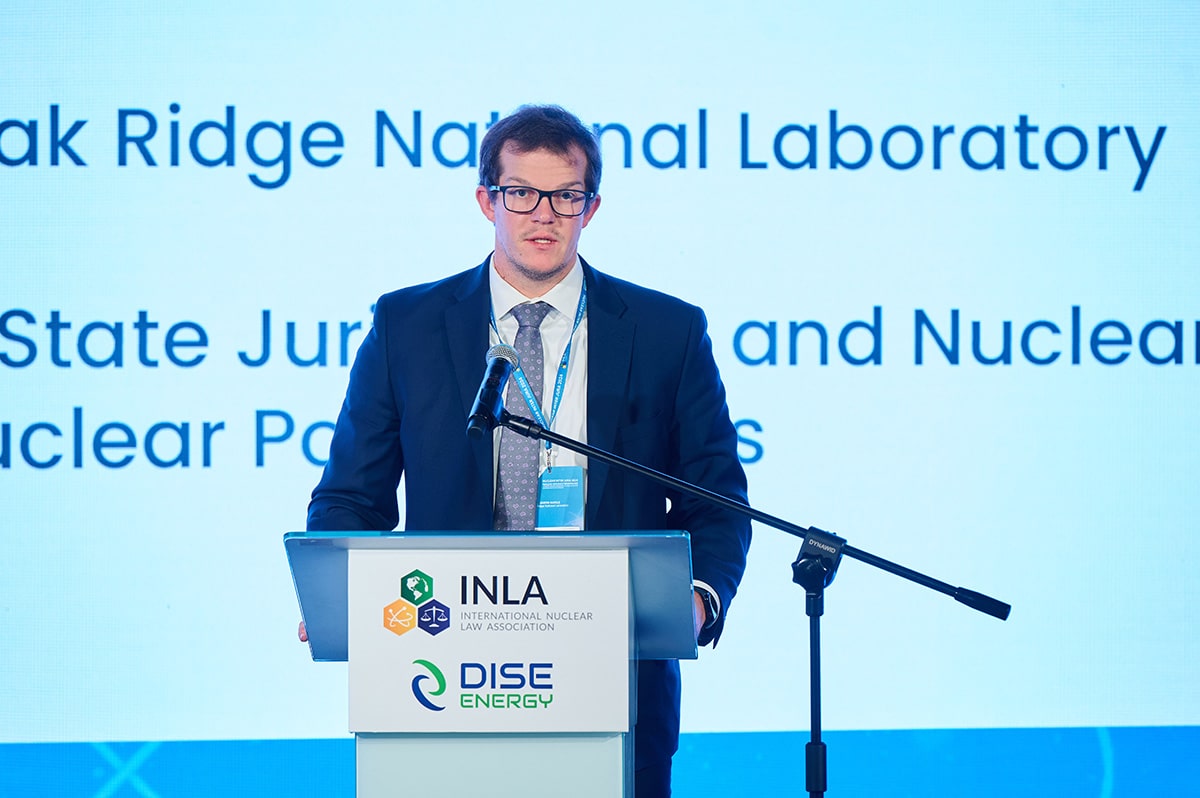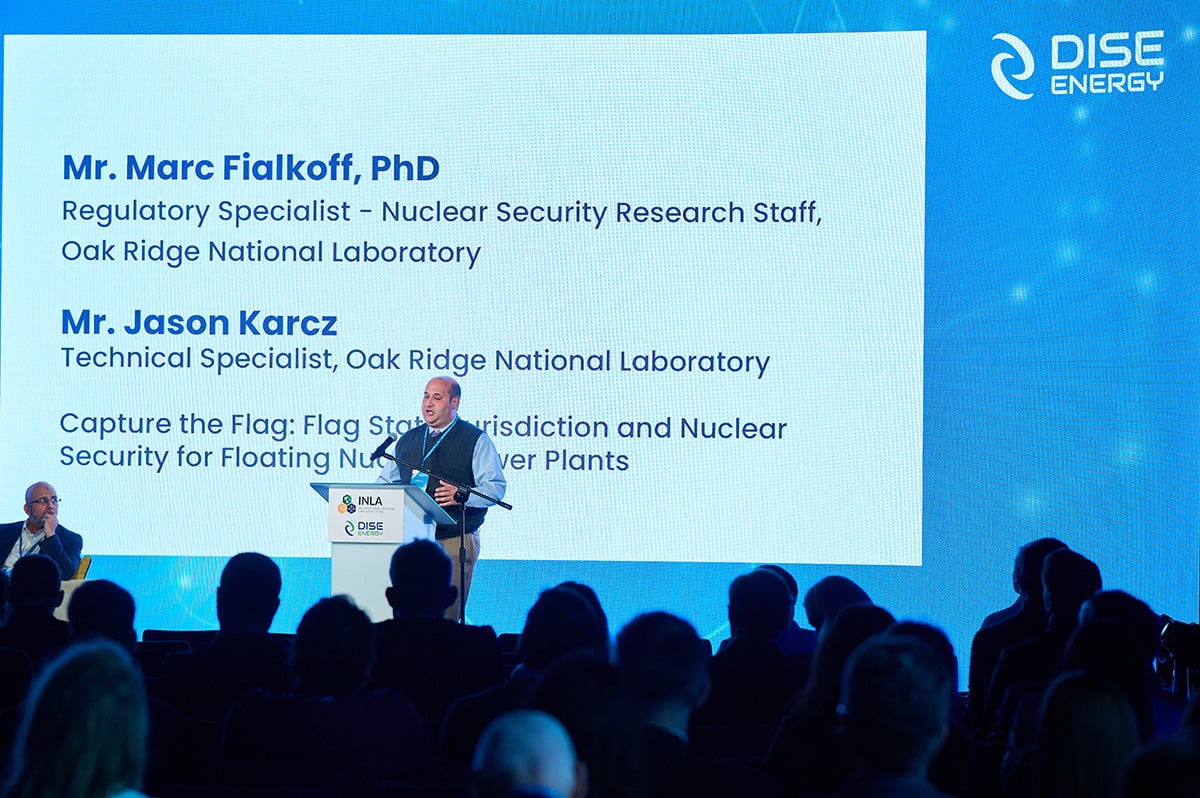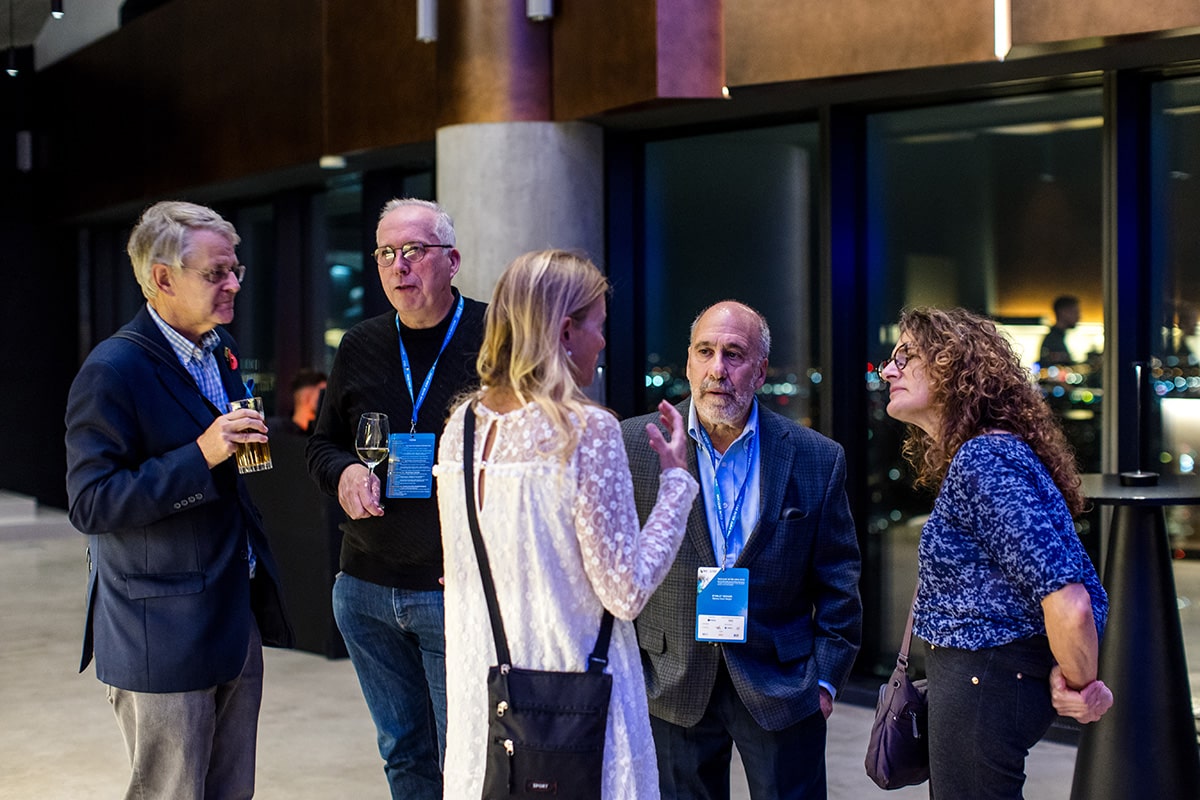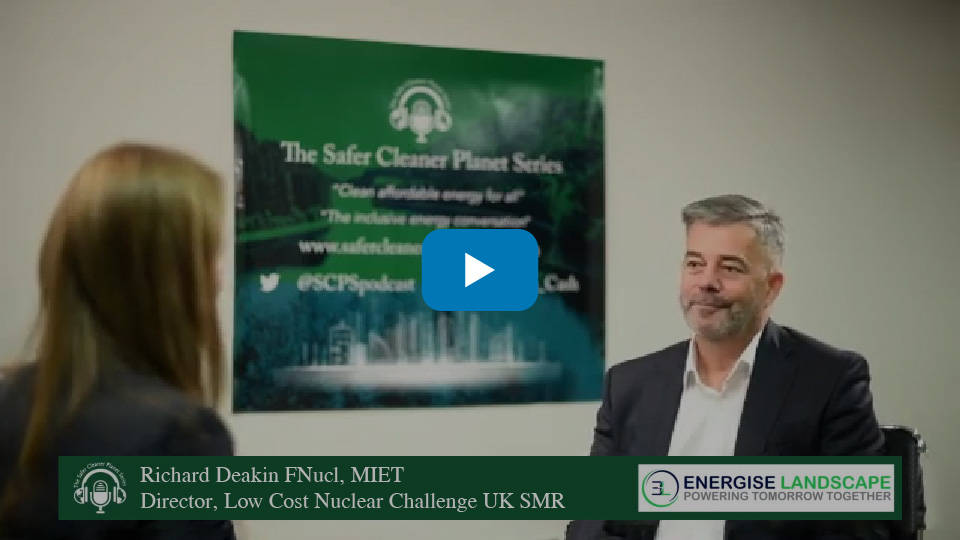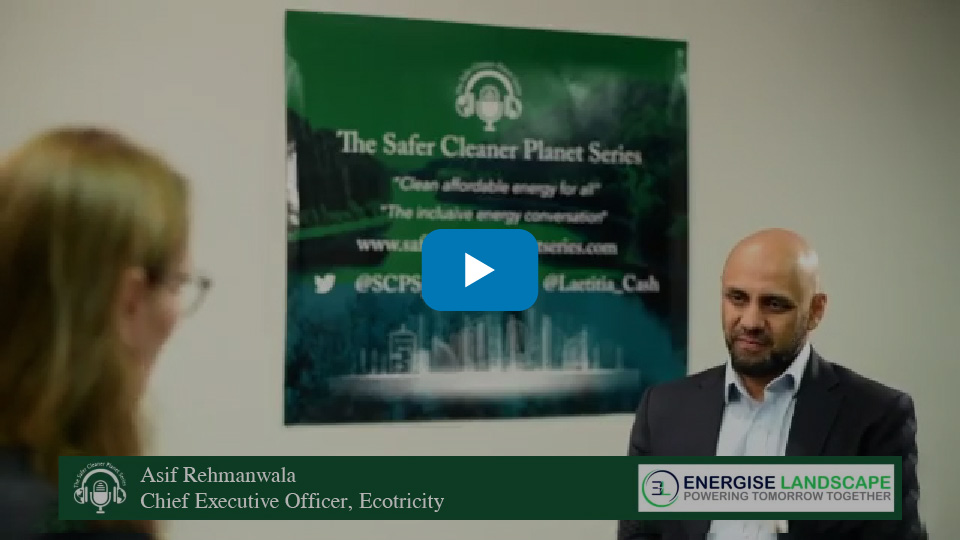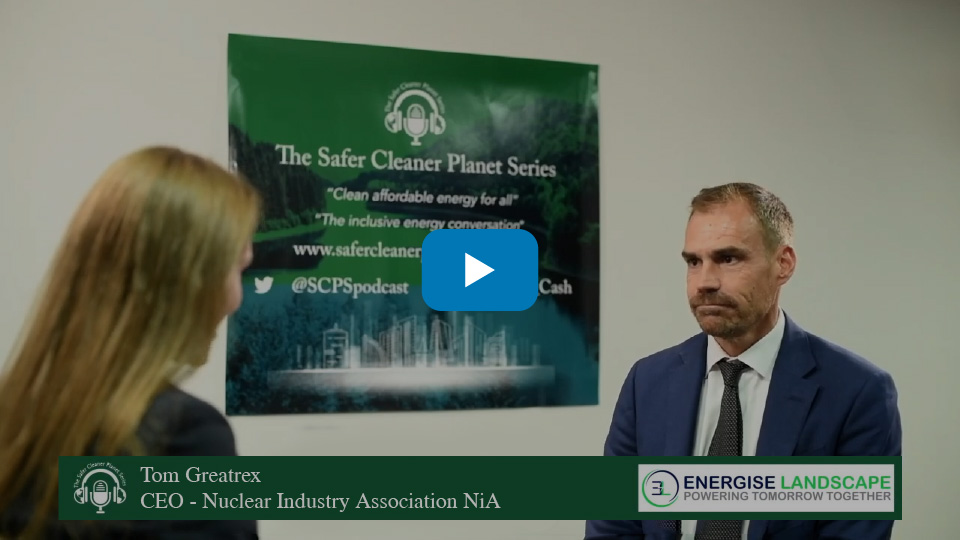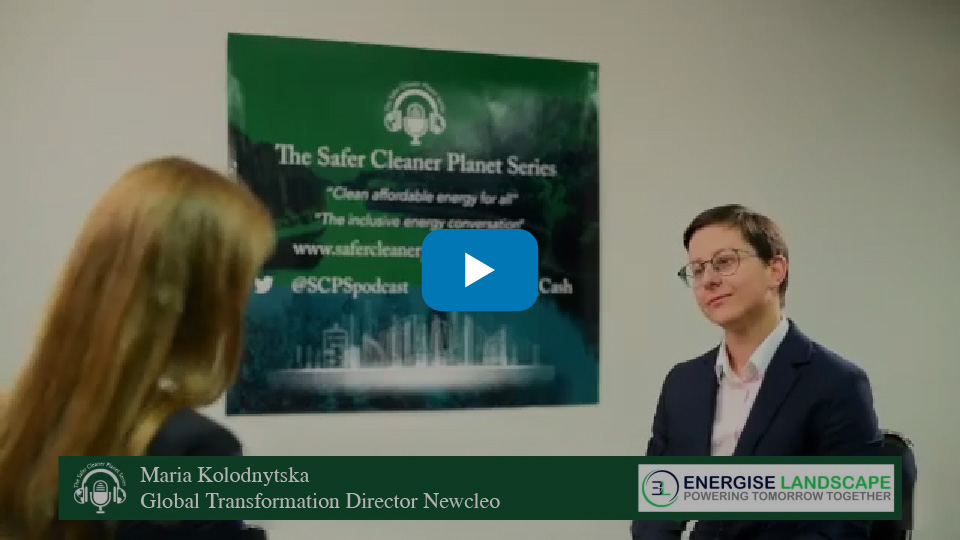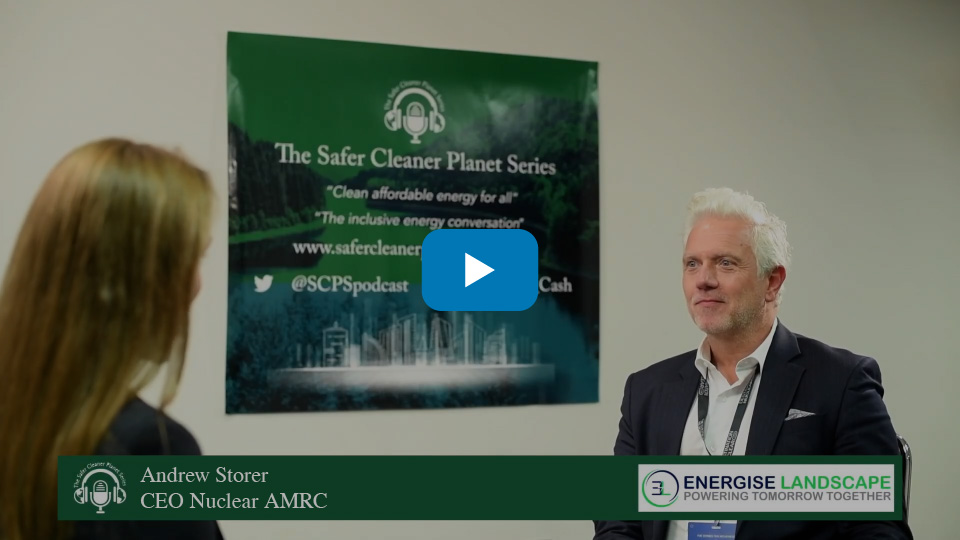Latest Episodes
Episode 12
September 2024, Energy Landscape UK Conference, London
Laetitia Cash interviews Richard Deakin (FNucl, MIET) Director, Low Cost Nuclear Challenge UK SMR Low Carbon Energy and Clean Growth (UKRI)
Latest Episodes
Episode 11
September 2024, Energy Landscape UK Conference, London
Laetitia Cash interviews Asif Rehwanwala, CEO of Ecotricity and Green Britain Group, Vice-Chairman Forest Green Rovers FC
Latest Episodes
Episode 10
September 2024, Energy Landscape UK Conference, London
Laetitia Cash interviews Tom Greatrex, CEO of NiA UK (Nuclear Industry Association)
Latest Episodes
Episode 9
September 2024, Energy Landscape UK Conference, London
Laetitia Cash interviews Maria Kolodnytska, Leader in Nuclear New Build, newcleo
Latest Episodes
Episode 8
September 2024, Energy Landscape UK Conference, London
Laetitia Cash interviews Andrew Storer, Founder of NucCol and Former CEO of AMRC
Latest Episodes
Episode 7
Thursday May 23rd 2024
Audio Only:
Laetitia Cash interviews Zion Lights, award winning environmentalist, science communicator, pro nuclear campaigner and founder of Emergency Reactor.
Latest Episodes
Episode 6
Audio Only:
Safer Cleaner Planet Series Episode 6, Laetitia Cash interviews Simon Bowen, Chairman of Great British Nuclear (GBN) UK's new nuclear delivery program about meeting the national imperative and the climate, energy security and affordability trilemma for 2030 and 2050.
Simon Bowen, Chair, Great British Nuclear – biography & background:
Simon introduces himself and tells the audience how he came to undertake the role of Chairman of Great British Nuclear.
Simon Bowen gives his professional background as a nuclear engineer working with submarines in the Royal Navy but left the nuclear industry when he was 30 for 20 years working in operations in the petrochemicals sector. He returned to the nuclear industry and ran the Uranium enrichment business Urenco in the UK. He then joined Babcock as the Managing Director of Cavendish Nuclear and was the Chairman of Magnox (responsible for the safe and secure clean-up of 12 nuclear sites and one hydro-electric plant), Chairman of Dounraey Nuclear Power Station in Scotland, followed by running the whole of Babcock’s Nuclear Portfolio which included submarines.
Talking Points:
Why Simon Bowen as Chair for GBN?
He admits he is outspoken and as he knew everyone in the industry and was not associated with any technology or company, he was independent enough to be considered for the GBN Chairman role.
Simon explains being invited by Prime Minister Rishi Sunak to put together a “sprint study” on what would it take to create a New Nuclear program for the UK
Great British Nuclear (GBN) – The Mandate
Laetitia asks Simon about his former role as Chairman of Cavendish Nuclear in the UK and to explain what is GBN’s mandate (Gwen Parry Jones current interim CEO of GBN) and the distinction and/or relationship between GBN and the Department of Energy Security and Net Zero?
Cavendish is a wholly owned subsidiary of Babcock which Simon previous ran and then formed the Babcock Nuclear Division which also included Defence.
Simon explains about GBN’s mandate. The sprint phase concluded after requesting input from all the nuclear systems domestically and worldwide, that because nuclear is such a large scale infrastructure investment and as it is a particularly risky investment at the early stages, before timescales and costs get proven then Government has to take a major role. The conclusion was Government has to have a program and “the program” is the most important word.
Simon explains what a “program” means. A predictable set of projects you can put on the ground which means investors know what they are investing in and they know there is long term opportunity for multiple projects to invest. The program is also very important for the supply chain.
Distinction between GBN and Department of Energy Security and Net Zero (DESNZ). The DESNZ determine the policy but GBN advises on policy with a group of nuclear specialists and GBN delivers the program.
Simon is the Non Executive Chairman and Gwen Parry Jones is the Chief Executive Officer.
How GBN is working to meet the 2030 and 2050 goals and also whether the launch in July 2023 of GBN represents a nuclear renaissance or nuclear revival?
Simon explains he thinks it is a massive renaissance for the UK because previously the UK government has just gone from project to project, so when Hinkley was announced, it was a single project, when Sizewell was announced that was a project, it was never announced in the overall context of a national imperative. The priority for GBN is decarbonization but importantly within the context of energy security, so the British energy security strategy is really what prompted the acceleration of nuclear within the UK because energy security cannot be delivered without nuclear.
How much nuclear is in the UK energy mix
Laetitia asks Simon to explain what is the amount of nuclear in our overall electricity generation currently and what is the gap GBN is trying to fill?
Simon explains that over the next few years there will be a reduction in nuclear energy for electricity generation because of the gas cooled stations are being decommissioned, which means we will get down to 7-8 GWs but if and when Sizewell C goes ahead and when Sizewell B gets a lifetime extension, so with everything we now have we will going get about 8 GWs with everything we have.
What percentage is nuclear generation with the overall pie relied on for the national grid today? Simon explains depending on which stations are on it is between 12-17 % but it will reduce back down to about 10% because of the station closures between now and the end of the decade, and the target (for 2030 and 2050) is to get to circa 25%. And that is represented in terms of policy of up to 24 GWs. This is really important because for an electricity system 24GWs maybe enough. However, in Simon’s view if you take the decarbonization of the overall energy system, then it is not going to be anywhere near enough, so the number could be significantly “north” of 24 GWs.
The UK energy security and Net Zero 2030 and 2050 targets
What is the target for 2030? Is to get 2 Final Investment Decisions by 2030 and that puts us on a path to deliver 24 GWs by 2050. So the delta GBN is working on is to get from 7GW up to around 24 GW and above. This is “huge” in terms of the amount of nuclear plants that are required.
UK Nuclear – Who are the main stakeholders? SMR/AMRs & Large Nuclear NPPs
Laetitia asks Simon to explain what the current capacity is and what the main stakeholders are, e.g. EDF and ask if Simon could explain whether GBN is mainly focused on Small Modular Reactors and Advanced Modular Reactors as opposed to Large Nuclear Power Plants?
Simon explains that EDF operates all the nuclear plants in the UK, he explains that after the reduction in nuclear generation Hinkley will come onto the grid and Simon says he believes Sizewell will go ahead but explains “that only takes the country’s capacity so far. He explains the UK/GBN are reliant on EDF as a Partner and they are very pro-British in terms of what they do, so we are very lucky to have them as the cornerstone of UK nuclear.
Simon explains the most important thing we have to do is ensure that Hinkley and Sizewell are successful.
Why are we going for Small Modular Reactors?
Simon explains the harsh reality is the big reactors are very large financial investments i.e. 10 billion a GW is considered “large-scale” prior to you being able to drive the costs down in time. In the UK that is a huge amount of money and all of this sits on the Government balance sheet. The worldwide industry has recognised that the way to get the cost of nuclear down is to do it smaller and make it modular.
That is important because once you have proven you can build them, the modularisation means you can do them in factories, so you should be able to build them quicker, so you should be able to get the cost and the time scales down. With the costs and the time scales coming down obviously the cost of finance comes down, and once they are predictable in their build; that’s once you have built the first or the second (of a kind) SMR that’s the point at which the private sector I think is an eminently investible entity or project to invest in as the returns will be long-term and predictable.
So why SMRs?
Once you have proven the First Of A Kind, you should be able to produce them faster and lower cost and it gives you a much lower cost of financing and therefore lower cost to the consumer.
Number of Nuclear Reactors in the UK about 6-8 numbers depending on the decommissioning schedule along with new nuclear plants Hinkley and Sizewell C coming on to the grid.
Simon explains running up to 2030 there will be two plants running which will be Hinkley Point C and Sizewell B which is a different design a pressurised water reactor, these are the two main plants that have a long term life, and then we will add Sizewell C to it and that gap between 7GW and 24 GW needs to be filled with more large nuclear plants and more SMR’s and more Advanced Modular Reactors.
GBN’s Job – Delivery of the new nuclear projects pipeline
Our job is to deliver these projects, we probably won’t get involved with Sizewell C, but everything else we will deliver.
Laetitia asks about the procurement challenge and Simon’s comments about the importance to de-risk and asks is there a difference between the approach to defence procurement and the one GBN is applying to nuclear delivering programs procurement? She also asks Simon whether against the backdrop of Russia and China reaching greater maturity with New Nuclear.
How are the Western countries collaborating to accelerate the projects playing catch-up?
Simon replies it will be public procurement yes, and the link to defence procurement is not really there, we may follow some of the same processes but it will not be regarded in that space. The main link to defence is through skills and supply chain, so we work very close with defence because of the skills and supply chain challenges, and there is a lot of work to do there. One of the main recommendations from the report was that we have to sort out the regulatory environment within the UK if you want to accelerate, so we have one for the best nuclear regulators in the world, we are very well renowned for that, and one of the key things we have to do is we have to get them to work with the international regulators, but we have to accelerate it, so when we do safety assessments you only do it once. So if you are doing a safety assessment in France or in Canada or in America or anywhere else you can use that to inform your safety cases and your regulatory regime within the UK.
That doesn’t mean you will change the regulatory regime in the UK but it does mean you should be able to accelerate.
The other advantage is you can compare and contrast and say why are they prepared to accept this in France and other jurisdictions, and we are not saying that is not safe enough. So there are real advantages to that, there is a massive piece of work to do with regulation to do with environmental regulation, the planning regulations, the grid connections and as an energy system.
What are we trying to do with the SMR program of delivering? Simon explains the SMR market is a global market, everyone is trying to do the same thing, new countries are popping up all the time, people are coming back into nuclear because they all recognise the benefit of nuclear is clean baseload power with a really high energy density, so it doesn’t take much space. Everyone is looking at this from Eastern Europe to Canada to America to the Middle East. So it is a global market.
GBN’s tender procurement “Competition”
Simon explains: What GBN has done is we have gone out with an expression of interest and we down selected to 6 new nuclear tech providers, the names of the companies are on the Government website (EDF, Rolls Royce, Westinghouse, GE Hitachi, Holtec, Nuscale), and the process we are in currently is we are about to launch an initial tender which will allow us then to get into really detailed due diligence and get ourselves down from the six tech providers we currently have to somewhere between 1-4. My clear preference is we end up with 2, so we end up with 2 fleets. And why do you want two fleets? Because you want resilience on the grid in the longer term, so you are not subject to class defects but also of course it’s a case of competitive tension to see who gets there first, which is very valuable.
So what are we buying? We are first targeting the technology vendor so that we are going to offer a contract that co-funds their technology through to Final Investment Decision. So we will work out a mechanism of investing in their core technology to support them through all the detailed design work and all the safety and regulatory assessments, to take them to the point we they are ready for the Final Investment Decision.
At that point, this procurement process also allows us to do a supply contract.
So, we will then contract with them for the supply of their equipment to build the power station.
The final part, which is the next part we will be undertaking next year, is we then have to secure sites, which we are now really accelerating to identify and secure the rights and sites to build these fleets of SMR’s on. And we will have to form development companies because each of projects for each of the sites will need a dedicated development company. And to give you some scale, these development companies will be the size of a FTSE 500 company, these are very very big programs and projects.
That development company we will either form as GBN, as a subsidiary of GBN or as a JV or a SPV in place to form the development company. And that’s the company that will develop the site, it will own the nuclear licence, it will go for all of the consents and it will buy the equipment from the vendors. So the contract between the vendors and the Development Company (DevCo) is how you will set that up. And they will then morph into construction and then they will form the generating company. So that’s the whole logic will work. The first part is about detailed engineering, regulatory approvals, through to Final Investment Decision. And then the option, as long as we need them to, to procure the equipment into the development company, to get it on the ground and built.
Laetitia explains GBN is acting as a project developer, is this a correct analogy?
Simon replies project development companies has a multitude of different definitions, we are the program management company, we run the program for the UK and we will have development companies that are subsidiaries which run the projects, so we will have oversight over the whole of the programs.
The predicted costs curve of SMRs FOAK & SOAK – lessons learned from megaprojects
Laetitia mentions the 6 companies that have been selected for UK GBN procurement competition, and the 500m hurdle that has to be overcome for any aspiring SMR/AMR player (including X energy), she asks once spent and the know-how acquired, how does that impact the costs thereafter? Will it then come down?
Simon replies that the first thing to say is First of A Kind costs are not understood, we people talk about these exact numbers, it is not an accurate engineering estimate because you don’t know the unknowns. There are significant number of unknowns that you have to overcome as you go through First of A Kind. And that is why the financing and the funding of a First of A Kind, is different from a Second and Third of A Kind, because when you are building a modular reactor, or a new reactor, the reactor technology itself will work, there is no question these will work, there is no question the technology will work because it is copper bottomed, well understood, well-known Gen III technology. I am not talking about things like Terrapower and X-Energy because they are Gen IV, I am talking about ones we are talking through. There is no question they will work.
So, what is the question? The question is how quickly can you build them? And how quickly do you overcome the challenges that you will undoubtedly come across. There is that wonderful book by Ben Flyvbjerg (and Dan Gardner) “How Big Things Get Done – The surprising factors behind every successful project, from home renovations to space exploration.” Anybody building anything should read that book, this is not a plug for his book, it just has all of the lessons learned about major projects and our biggest pitfall is everyone thinks they are different, and everyone thinks they are going to be far luckier than everybody else, but it is the rigour you apply to these projects that will make them successful.
So, never starting construction until you’ve completed design, resist the temptation to be forced by the market to make these milestones and put a spade in the ground when you are not ready, those will be decisions that we will regret. The real rigour that is required in First of A Kind, that will de-risk that project. Is it helped that people like GE Hitachi, if we end up choosing them, are building in Canada, well of course it is, we have a really good relationship with OPG. We have a great relationship with them because we all learn from each other, the nuclear industry is actually a global family where we all learn from each other, so there is a real emphasis on learning from each other.
So that will cover the First of A Kind technical risk, First of A Kind national risk because it is a different environment with a different regulatory framework with a different labour laws and all those things and different skills that are available, and different supply chains.
So whilst you will learn a huge amount from the Darlington GE Hitachi/OPG project in Canada, of course you will, there is a lot to learn from what you do in the UK.
So, we have to be mindful of the fact that the current estimates.
What I am worried about? I am worried about people sticking out numbers into the market that everybody believes and then when those numbers go up, which in virtually every mega project they do, everybody turns round and says well it’s just like every other nuclear project, we are far better off being really honest about what those costs are and the level of risk we take with A First of A Kind, and then being very bullish about what we do with A Second of A Kind.
Simon: Final point I will make is what makes Second of A Kind, to one of the points in your question, is at a point where you have your regulatory design approved, from First of A Kind to Second of A Kind, you are bound to learn some stuff, but your change the absolute minimum, so you have to stop the engineers tinkering with the design unless it is absolutely essential, because the absolute cost will fall off a cliff once you have fixed the design, and your know exactly how to build them and you stick to it, you don’t change it, the point at which you change it, is the point at which the cost goes up.
SMR & AMR UK financing models and state aid
Laetitia: For those who are not aware of how large infrastructure projects are financed, you have a model that’s called Contracts For Difference, and the RAB, Regulated Asset Based Model, which helps to raise capital which aims to give some guarantees to the financial establishment, how different will financing be for SMR/AMR as distinct from Hinkley Point & Sizewell C and is it very different from how renewables have been financed?
Simon: You’re absolutely right, this isn’t my area but I will have a crack anyway! The financing model is not yet agreed with Government.
Our (GBN’s) firm recommendation and the belief around the system is the RAB model really works because it absolutely keeps the level the financing costs down, because you can charge it to the consumer from the start. So, we really believe the RAB model is the right thing to do, but that is something we at GBN have to agree with The Treasury as we go through to the next stage. Now, having said that, the next stage of what we do with detailed due diligence will be about the financing models that each of the vendors are prepared to bring to the party, because there are multiple differences with financing models that each of the vendors have access to, or believe they have access to, and we have to drill into that to really understand if they have got legs and if they do, whether that is something the UK government can back and support.
So, it is too early to comment on exactly what the financing model will be, our strong preference will be for it to be RAB, and then we can see what the private market can bring in. We think there are some quite interesting models, that we could use, that would bring private financing earlier than we probably believe. It is easy to say we could probably bring in private finance on Second Of A Kind, on a very affordable level, but we think there may be some models where you can bring it in earlier. And as we develop that we can start talking about that, but it is too early to start talking about that.
Laetitia: And do you think there needs to be a sovereign guarantee for these projects, or not necessarily?
Simon: It depends on what the scope of that is, the government support package that will exist for Sizewell, you have got to manage the risk through construction somehow, someone has got to bear that risk, what’s the lowest cost of doing that? It’s going to be a combination of Government finance and private finance using debt and equity, but the balance of all of that has got to be worked through, so the risk in construction, there are a number of companies are saying they can manage themselves. Well, we really want to test that is where people have become unstuck, in a number of projects globally, because the numbers, we the things don’t go well, the numbers are very large numbers, and we have to work out whether you do or you don’t need a government support package that acts as a kind of cap for risk.
What we also have to consider is operating risk because the outage risks, so when the nuclear plant comes down/off, and it cannot generate electricity, then in nuclear terms, if you get a significant defect you can be off for a long time, and it is not measured in days, it can be measured in months, and it is something Sizewell would be looking at, which is, you as you a Government support package protection, when the plant is off, as well as construction protection. So it is not a simple question, we’re not ready to answer it yet but we know the mechanics we would use, as we get the data and information in from the vendors and then we determine; 1) what we are prepared to do 2) the credibility of what they are putting on the table.
Decommissioning & waste integrated into the financial package & licensing
Laetitia: And regards to decommissioning and waste costs, am I correct the way that works is it is put into the financing at the start, it’s built into the whole financial package, is that correct?
Simon: Yes, and it is also built into the regulatory package. So, the whole thing about waste, there is always a whole pile of stuff on social media on waste and the scale of waste.
The scale of the waste is very small and with the newer plants and the way in which they are built, the level of the waste coming out of the plants is far far smaller than most people would imagine and that has been in place for the traditional reactors, and as a critical part of the licensing the vendors will absolutely have to spell out what their decommissioning plans are, and that is quite different from any other industry.
Sharing the pie: renewables alongside new nuclear on path to decarbonisation
Laetitia: So coming to the slightly more controversial subject of how renewables is getting support from the British Government alongside nuclear, I don’t know exactly the percentage of renewables on the grid, there has been talk about there being possible blackouts because of we haven’t got our nuclear capacity up which is required for baseload power. There is pressure from the environmental community and international community to decarbonise the grid, so we have a situation where the renewable sector cannot quite deliver on this decarbonisation agenda, and there is also an issue with regards to grid connection whereby even if we get these renewable projects up and running, the solar and wind that are in play at the moment, it is still going to require ten years before they are connected to the grid, so there is a significant gap, the experts in energy understand this, the British government understands this is a security of energy and around an energy crisis as a topic, obviously the Ukraine war has exacerbated that, so the imperative of what GBN has been set out to do, is actually very serious, so if you could just talk to why nuclear? In terms of how it sits with renewables sector? And the imperatives.
Simon: Yeh sure, the system. This isn’t nuclear versus gas, actually it is exactly that in terms of replacing gas for decarbonisation, but it is not nuclear versus wind or solar, or CCUS or the broader energy requirements like hydrogen and synthetic fuels, they are all a system, and they are all absolutely intertwined and they are interconnected, so what does nuclear bring, nuclear brings the steady baseload power.
One of the criticisms of nuclear is it is not intermittent, well the newer reactors, the AMR’s in particular sure they can be intermittent reactors, and there are a number of designs which allow you to flip on and flip off the grid and keep the nuclear power plants running at maximum power.
Simon: So how does all that fit together? Sizewell are talking about siting a hydrogen plant right by the side of them, for the very reason of intermittency and so how do you do that? How do you approach the system? The big “missing” in the UK is the spatial plan, we do not have an energy system (not an electricity system), an energy system spatial plan which determines what you want and where you want it and how much you want. And it’s a crucial “missing”. So when I talk about 24 GWs, the numbers up to 24GWs and that is actually quite meaningless, what you need is, a target that you are going to be driving for nuclear generation. And then you have to map out across the UK what goes where. And of course there is logic in having industrial clusters, so why wouldn’t you have a grid connection, which takes on shore wind, allows you to site a hydrogen plant right along it with some captive demand with something next door, like a refinery and put a nuclear plant by the side of that, that overall energy system is really attractive. To your point on grid connection.
The imperative of the skills and grid connections gaps
Simon: What are the two things that keep me awake at night? One is skills, and the ability for us to get the skills that we need and we are doing a huge amount of work in that and the second is grid connections, and grid capacity and there are two elements to that, the first thing is somewhere between 10 and 14 years to get a grid connection and there is a real danger with some of the renewables that you could end up with stranded assets, and everyone is well aware of that, but there is a substantial amount of work that Nick Winser, the grid commissioner has done, and it’s very aligned to the work that we’ve done which is how you accelerate grid connections, and the target is to half to somewhere around 6-7 years, that will be crucial for us but because of the pace of nuclear and how long it is going to take us to get on-line, my belief that problem will be resolved and we will know how to do grid connections quicker. The piece we have got to get our heads around quickly is how do you fit all of that system together, so you put the plants in the right place where the demand is required and you consider it as an energy system, not an electricity system, because you have got to look at it as that. You can’t look at it in isolation just as power generation.
New nuclear UK Sites and the intermittency issue vs energy security of supply
Laetitia: That leads me nicely onto sites, and I have never heard before, this is the first time, that there is a criticism of nuclear being not intermittent, because I am just mindful of Dieter Helm at Oxford University who wrote a who book, The Carbon Crunch. And he was basically making the case that renewable energy’s shortfall is that it is intermittent and therefore it is not providing reliable baseload power, so can you just talk to the intermittency pros and cons for renewables, just for those who aren’t aware. If you could talk to that.
Also, if you had a map of the UK, obviously you have sites like Hartlepool on the North Eastern coast, and then on the North West, you have Moorside, can you give a sense of the where the hubs of nuclear development are likely to be and obviously Wylfa in North Wales.
Simon: The intermittency is a little bit of mischief making, I’ve got to be honest, from the renewables teams because this is kind of historic, the whole energy industry has now matured to a point where everybody recognises we need to co-exist, so everybody recognises that battery technology will develop far far faster than we will imagine and will become a critical part of it, but there will be times when you are just chucking out loads of offshore wind, and you don’t have anywhere to put it and it does make sense to turn the nuclear plants down because you have run out of capacity, the hydrogen plants are running flat, or whatever you’ve got, all before the hydrogen plants commissioned, then there is a world where when the wind is blowing and the sun is shining, you may not need the nuclear plants running flat out. So you do need a bit of flexibility to be able to do that and there is a big debate there for what baseload power is and what scale that needs to be.
So the intermittency, it is called system planning and system planning and system operations.
Laetitia: And as Dieter Helm said and maybe people are not so aware, the baseload power is provided by fossil fuels, provided predominantly by natural gas.
Simon: Absolutely
Laetitia: So the whole point about what you’re trying to achieve is to reduce that over time in an energy secure way, is that correct?
Simon: Yes, that is absolutely right, it addresses the energy security issue. So why did Prime Minister Boris Johnson start this because he didn’t want to be reliant on foreign gas, we all know that, so that was the prompt, but of course then the great benefit of it is, is once you get away from these forms of foreign gas, of course you need to have gas from a swing perspective or to make up your baseload capacity, but once you have nuclear there you are in control from a nuclear security perspective of your supply of electricity, so there is a huge benefit to that.
Can new nuclear be affordable for the public and to power industry?
Laetitia: Do you believe that nuclear is the best way to solve climate security and the energy security issue and also eventually the affordability issue, because at the moment we’ve got renewables to quite a large extent in this country, but our bills are very high and they don’t look they are coming down anytime soon, it’s the trilemma as they say.
Simon: It’s the trilemma, and I love the way they put that, so you would not be surprised to hear me say 100% yes, because I would not be sitting where I am if said no, would I? Do I believe that, absolutely I do, is it low-carbon? Of course it’s low carbon. Is it baseload and secure power? Absolutely it is secure because you know what the reliability of nuclear stations are, they are nuclear stations that are somewhere between 88-94%, they are on-line all the time. So that is absolutely a core part of what nuclear brings to the grid.
So, it does come back to this whole system argument, that they have a natural.
You had a second part of the question?
Laetitia: No I was just saying do you envisage a time once nuclear plants are built, and SMR’s been built, will the costs from the public, not so much from the investor point of view regards return on investment, but from the public interest perspective in terms of affordability to power our industrial base as the UK, this is for me a core issue, from a public interest perspective, we want to have affordable energy to be able to power our economy. Is that something you think can be achieved?
Simon: No doubt, so the numbers we have done, and we have independently verified them, is that if Hinkley point C had been on-line last year, it would have saved the consumers £4.2 billion, very simple. That is the existing strike price. People talk about the £92 strike price as being outrageous, but with the current energy price, nuclear saves a huge amount of money for the consumers and people get fixated on the capital costs, you can’t think about, these are long long term investments, these are plants that can run between 60-80 years and the capital costs is amortised over that time, and when you look at the unit cost on a through life basis, it is as competitive if not more competitive than renewables. So, you have to think about it in that context, so it is really important people remember that that number, because it would have saved 4.2 billion for the consumer, so there is no question, that is gives you, the answer to all parts of the trilemma, particularly cost.
UK new nuclear sites Phase I and Phase II:
Laetitia: So going to Phase II, as I mentioned Phase I is the selection of the tech vendors, and Phase II is about the actual projects, if you could talk about the sites currently being looked at and how the ones that don’t necessarily get to Final Investment Decision that you would be supporting them in other ways.
Simon: So what we are starting off with the chosen vendors we have and that will inform the sites that we need, all of this is to do with scale and pace, energy security is the foremost – priority one is energy security and priority 1.1 is decarbonisation, but it is energy security first, so we have to go for scale and we have to go for pace, so we are going to be looking for sites that we can build multiple reactors on, so all the infrastructure is done once, so therefore you get the costs down. The sites that exist within the policy statement at the moment, are places like Wylfa, (North Wales), Oldbury (Bristol), Heysham on the NorthWest coast and Hartlepool on the NorthEast coast and then you have sites like Bradwell which is currently looking at being developed by the Chinese, which is down in the SouthEast.
So the way I look at it, and it’s just the way I look at it, is I divide the country broadly into 5, not including Scotland because Scotland is not currently in favour of nuclear power, so for the NorthWest which includes Moorside, which we talked about which is just outside Sellafield. Moorside over to North Wales that is a natural area you will be putting reactors, no question in my mind. South West you have all the capability that sits with Hinkley, but you also have Oldbury, and Oldbury is a very good development site. SouthEast you’ve got Bradwell which again is an attractive site, which is currently in the existing policy statement, and then Hartlepool in the NorthEast, the middle is where you could build the factories, and may you don’t build them but from a skills perspective we divide it up into five and say OK what would you do where, this is for Phase 1 Wave one. We will need every site we can possibly get, to be able to deliver up to 24 GW’s, so the sites that are in the current policy statement, are just for the start.
Advanced Modular Reactors (AMRs)
The really important part for us to think about, and this does require a major change, is that the AMR’s, the Advanced Modular Reactors, will require a different regulatory regime because they are inherently lower risk, because they need a much much smaller zone around them, cause if you take what X-energy claim, X-energy would claim they are passively safe, they are walk away safe, which is a good way of talking about it, because it means it doesn’t matter what you do with it, you can walk away and its safe. At a point where you get that as an Approved Method of Operating. And everybody recognises that the risks are miniscule and therefore you can walk away from the plant, you can stick them anywhere. So, you don’t have to worry about nuclear plants, you’ve got the public debate to win, but you can put them anywhere. What you then do is open up for both for decarbonization which is huge and your open up so many different sites and of course you start dealing with the grid problem, because you can do a lot of this stuff, off grid.
So AMR’s are a critical part of what we need to do next, and they will require a different regulatory regime, and that gives us access to a much broader set of sites.
Laetitia: And that is for HTGCR generally or it’s for Molten Salt Reactors?
Simon: There is a range of them and they tend to be much higher temperature and therefore they tend to be used for any form of manufacturing that requires heat.
Laetitia: Because there is a project in Japan I believe, which has been going quite safely for a while.
Simon: and China yeah.
The UK skills & security of supply chain imperative
Laetitia: If we can just talk about the skills and supply chain, security aspect. So, from my point of view nuclear is providing the highest wages in the sector, the longest employment security, by far. So, the new generation coming through universities, through training programs, can you just talk to how you are joining the dots with the projects will be, the vision for Great British Nuclear and really about inspiring the next generation as well, in terms of where we have been in the past, and how you want to go forward, especially with the universities, and whichever institutions are coming together to make this happen.
Simon: Yeah sure, we have a nuclear skills task force that is looking at all of this, and we have a fabulous group of people running an organisation called Destination Nuclear, and it’s to exactly your point, how do you make nuclear more accessible?
So, if you look at the Navy adverts on the TV, it talks about born in Sheffield made in The Royal Navy, that sort of style of advert is exactly what we are looking at for the industry to access both mid-career people and more graduates into the industry, we need probably, we need to up our rate of recruitment from around 7,000 a year to about 20,000 a year between defence and civil, so the attraction and retention is hugely important. Destination Nuclear is going to be the campaign we are going to run and the website we are going to be forming to allow people to come in and get a window on the nuclear industry. And that will make the industry much much more collaborative, so it is something we are finely tuned and focused on, but we recognise we have got an awful lot of work to do.
Laetitia: Where are the hubs for the university programs and jobs generally speaking?
Simon: “Obviously, Manchester university is renowned, Imperial is very good, but we are now broadening out because those are the traditional hubs for, we need a huge amount of PHDs and between ourselves and the Fusion program which we work very closely with, we also need a huge amount of PHDs, so there are multiple universities around the UK, including places like Strathclyde, that have real nuclear expertise. We are broadening out now, to look at taking the work to where the workforce might be as opposed to them having to move where the nuclear hubs are. So, for example, Rolls Royce has just agreed to set up a Rolls Royce Submarines hub in Cardiff, in Glasgow, in Dounreay in Northern Scotland, because they recognize they don’t need to have the people close to Derby, they can have them where they actually exist. So we are looking at across the UK, so it would be a fallacy on our part, so say we are just going to focus on one area or another, because that is not going to give us the answer we need.
Nuclear’s Social licence:
Laetitia: OK, so just on the point of acceptability, you mentioned that just earlier on, in the 1970’s there was a CND movement in the UK and I think a lot of people, Oliver Stone did a documentary called Nuclear Now, there are a lot of films and documentaries being made around this subject, aimed at addressing the myths around nuclear weapons and civil nuclear. My understanding is that the British government, I’m sorry the British people are quite in favour of nuclear power, and there is not as much resistance as one might imagine.
“what’s your understanding of the acceptability at a national level, I don’t know if there is any polling that has been done, and also at the sites because my understanding is that where the sites are, the local community are very keen to have these jobs and that job security, there is not a big anti-nuclear movement.”
Simon: No I think that is accurate, and again I have to be careful here, as I would say this would’nt I?, but in all of the sites. So let me start off on a site basis, on all of the sites within the travel to work area of every nuclear site I have ever been in, there are incredibly pro nuclear, because of the quality of the jobs and the longevity of the jobs, it is a community based around a nuclear power station, and therefore the acceptability locally, is really really good, and therefore of course you’d want to build locally, so you want to build on existing nuclear sites. Nationally, Julia Pyke from Sizewell C talks about this, and it might not be correct but the national acceptability of nuclear has risen to something like 65%-70% now, purely because it is recognised as being part of the journey to Net Zero, and that without nuclear you cannot address the energy security issue. So, the nuclear weapons side of things I think is considered quite separate and rightly so, nuclear power and although you have got nuclear powered submarines, the way you design and build them, is not dissimilar from how you build civil, so you can put all that lot together and say, “do you understand nuclear power and what it gives you?”,
Yes you do, well so it gets very very high degrees of acceptance because of its strategic national importance, I think.
Laetitia: “With regards to Phase 2 and selecting the companies that you are confident can deliver for the 2030’s” “To what extent do you believe there is a non partisan or rather bipartisan support on both sides of the political equation, looking at the nuclear association it looks as though there is broad support, so are you confident about that, if there is a change in Government?
Simon: Yes, we are and how do I evidence that? We have a nuclear week in Parliament, and at the Parliamentary reception, Andrew Bowie who is the nuclear minister, and Ed Miliband shared a stage and the only thing they disagreed on was the importance of gigawatts (GWs), so Andrew quite rightly said we are really quite focused on the SMR to start off with and Ed Miliband stood up and said so are we, we think this is really strong. So the reality is, the Labour cabinet from the Labour Party appears to be as supportive, as the conservatives. The national imperative is so clear, there is nothing we have seen that would indicate the direction of travel or the pace will change.
Laetitia: Well that is wonderful, I think we have covered everything Simon, I really enjoyed that conversation, thank you so much, best of luck with Phase two of GBN and hopefully maybe we can have enough interview after the Next Parliament when you are further down the line with everything being rolled out.
Simon: Fantastic
Laetitia: Well done for everything you are doing and thank you so much for your time I really appreciate it. And have a good run up to Christmas.
Simon: I will, and take care. Goodbye.
SCPS top energy transition experts & thought-leaders corner
London
Milan
Rome
Geneva
New York
Los Angeles
Austin
Paris
Berlin
Madrid
Zurich
San Francisco
Houston
Seattle
Dubai
Abu Dhabi
Riyadh
Athens
Johannesburg
Latest Episodes
Episode 4
Wednesday July 26th 2023
Audio Only:
Sector: New Energy, Infrastructure & Innovation (including hydrogen) Systems
Dr Shannon Bragg-Sitton is the Director for the Integrated Energy & Storage Systems Division, Idaho National Laboratory (INL)
She is internationally recognized for her work on innovative applications of nuclear energy and other clean energies. Nuclear energy can indeed go beyond supporting “only” the electricity grid: it can supply energy to various industrial, transportation and energy storage applications. Thus, Shannon’s research enables us to maximize energy utilization, increase energy production facilities’ profitability, and improve grid reliability and resilience.
Among many leadership roles she held during her career, Shannon served from 2014-2023 as National Technical Director for the Integrated Energy Systems program, supported by Department of Energy DOE Office of Nuclear Energy.
Shannon is also currently the Chair of the Generation IV International Forum (GIF) Task Force on Non-electric Applications of Nuclear Heat (NEANH). Shannon holds a PhD in Nuclear Engineering from University of Michigan.
Talking Points:
• About INL’s history:- U.S. Department of Energy’s’s Office of Nuclear Energy Idaho National Laboratory (INL) is one of 17 national labs in the US. Was originally set up under President Eisenhower’s to support his 1953 ‘Atoms For Peace’ initiative that sought to transform the atom from a lethal WMD, into a safe civil nuclear programme that is a benefit for mankind. INL has lead scientific innovation for more than 70 years, having built 52 reactors operating on INL’s 890 square mile site since 1949.
• INL’s significant scientific and technological innovatons include; i) the first usable electricity generated by nuclear power ii) the first city powered by atomic energy (iii) the first nuclear propulsion systems for Navy submarines and aircraft carriers. Their legacy now includes the advancement of small modular reactors, microreactors and the Versatile Test Reactor program.
• INL’s activities in general, how INL supports the “nuclear revolution” and how it aligns with DOE’s energy strategy. Dr Bragg-Sitton shares about some specific projects, developments and prototyping including:
• How nuclear energy will support climate mitigation, energy security, efficient land use, boosting innovation jobs and academia, sustainable local and indigenous communities and help to decarbonise heavy industry including steel manufcturing or mining and provide a broad range of flexible applications for generating clean power, heat and hydrogen.
• INL’s work on Small Modular Reactors (SMR) and other advanced nuclear reactors. In particular, Dr Bragg-Sitton explains the important distinctions between the different types of reactors and how their affects their range of applications. Also shares how INL supports new breaking ground projects in the U.S. and in the world.
• Perspectives on SMR/advanced reactors’ pros and cons, markets, commercialization, challenges, prototyping, investments and political support.
• INL’s involvement in developing advanced fission systems and continuing operation of the current fleet.
• Laetitia Cash asks about the environmental movements’ main issue with nuclear energy, including radiation and perceptions from well known accidents in the past, in addition to the often cited issue of dangerous nuclear “waste” or as Dr Bragg Sitton perfer to call “used fuel” which she goes onto to explain is smaller scale than most imagine, meticulously managed, monitored and recycled whenever possible.
• Dr Bragg Sitton shares about how INL activities and other countries similar activities featured in the recent Nuclear Now documentary by Oliver Stone [which is based on the book by Joshua Goldstein and Staffan Qvist A Bright Future: How Some Countries Have Solved Climate Change And The Rest Can Follow].
• Dr Bragg-Sitton shares some examples of INL’s main technology providers joint programmes and regulators with whom INL collaborates with and how such ventures are being approached to assist in the R&D phase ahead of commercialisation readiness.
• How INL is now promoting nuclear energy and encouraging a new generation of visitors to their TREAT [Transient Reactor Test Facility] site, [including recent a visit by pro-nuclear youth social media influencer and model, Isabelle Boemeke, [on Twitter @isodope]. Dr Bragg-Sitton concludes the interview sharing how the INL is focused on educating and encouraging more young people to STEM (Science Technology Engineering and Maths) and as a place for the public to better understand the nuclear industry’s innovative role in decarbonizing electricity, heat and transportation and in doing so significantly improving climate and energy security and providing safe clean energy for many sectors across the world.
Episode 3
Wednesday July 26th 2023
Audio Only:
Sector: New Energy, Infrastructure & New Nuclear Innovation (including hydrogen) Systems
Carol Tansley, Vice President UK Nuclear New Build Projects at Advanced Modular Reactor firm X-energy (with their Xe-100 “Four Pack” of reactor units and Triso Fuel package)
Carol has extensive experience in delivering major programmes and change transformation in the UK and Middle East having previously worked at Emirates Nuclear Energy Corporation and Nawah Energy Company, over consecutive years as:
Head of Programme Management
Director of Strategic Programmes & Director of the Operational Readiness Control Centre, Barakah Nuclear Power Plant in Abu Dhabi, United Arab Emirates
Prior to her nuclear career, Carol served as a Senior Director for PWC in the UK and UAE and worked with Accenture delivering some of the largest UK public sector change programs.
Carol is a graduate of Aston University in the UK. She studied at the Ecole Superieure de Commerce de Nantes in France, and in 2023 she was awarded a Distinction from Oxford University for her Masters on Integrated Project Development and its potential to improve performance on nuclear megaprojects.
Talking Points:
• Introduction and Carol Tansley’ UK, French and UAE resume and her celebrated role building the first ever 4 nuclear units in Barakah, UAE from scratch. (Tansley has the Operating Licence certificate framed on her wall).
• Laetitia Cash asks Tansley about how X-energy is thinking about COP28 in December 2023 in Abu Dhabi, given her background there and with Great British Nuclear (GBN) just being launched July 2023.
• Tansley’s background: She joined the Barakah project in 2014 and delivered the nuclear plant’s first unit 2 days ahead of schedule and on budget. Which Tansley says given it’s an oil nation played a very important role in the energy transition and with decarbonization.
• Tansley is asked if she can give the listeners a sense of the scale of what an Xe-100 can provide for customers against the backdrop of the nuclear industry historically not being their own best communicators and operating in their own silo/echo chamber. Safer Cleaner Planet Series was founded to provide the full range of energy choices to be explained to marketplace, so that the experts focused on sustainable development and energy security can make the most informed decisions based on companies and organisations telling their own stories first-hand.
• As new nuclear (NN) can alleviate fuel poverty and assist with climate mitigation, cash asks Tansley if she can give an idea of the scale and how NN has helped UAE meet their baseload power needs?
• Cash asks Tansley to explain, in the context of Great British Nuclear’s launch as a key component of UK’s energy transition towards decarbonization of the electricity supply (additionally heat and hydrogen for fuel), what are the main goals the UK Government has set for rolling out a new nuclear programme.
• Cash asks Tansley about the main merits of new nuclear as part of the “Nuables” solution X-energy is promoting? Tansley’s reply focuses on the Xe-100’s ability to “provide reliable stable baseload 24/7 but also operate flexibly as a compliment to renewables, including wind and solar, as part of this transition.
• Cash asks if Tansley can explain X-energy’s Xe-100 reactor attributes, what kind of reactor they are bringing to market and how their reactor differs from other technology providers, given the X-energy package also includes Triso Fuel and accompanying facilities to produce the fuel.
• Tansley discusses High Temperature Gas Cooled Reactors as Small Modular Reactors (SMRs) and how they are “cheaper and faster to build”, “extremely safe” and as such “takes it to the next level.” She explains how it, “helps to promote clean electricity as well as the generation of high temperature steam which enables effective decarbonization of district heating and heavy industries such as chemical processes (e.g. the Seadrift, Texas, USA 4 pack SMR plant planned with Dow Chemical as their first major customer).
• Explanation of the additional safety attributes of the “pebble-bed-reactor” encased in a unique ceramic and carbon ball that contains the nuclear fuel/waste within it. (80 MWe or 200 MWth of high temperature steam provision and using a fleet/modular approach)
• Cash asks why X-energy chose, uniquely, to include Triso Fuel and production as part of the overall commercial package/product? Also asks Tansley to explain about the US TRISO-X Fuel Fabrication Facility (TF3) creating 400 jobs and to be commercialised and operational by 2025, in Oak Ridge, Tennessee, USA.
• Tansley explains X-energy design, develop and manufacture the reactor and the fuel, talks about the Pebble-Bed reactors (PBMR) coming on line in 2029 and the number of reactors the fuel aims to supply.
• Cash observes the Xe-100 reactor has considerable flexibility for applications making X-energy unique, what are these? Able to produce steam, heat and hydrogen, is there anything missing?
• Tansley adds that as well as providing stable baseload electricity, X-energy’s Xe-100 “can also load follow” to help keep balance a grid fed by renewable generation.
• Cash asks Tansley to explain X-energy’s “four pack” rationale and approach to comercializing new nuclear modularization? What is the scale of power/heat households/customers one to four units can supply? The decarbonization of mining in remote offgrid locations dependent on diesel generators for power. Ability for Xe-100 to provide electricity also for local indigenous communities, a kind of “democratization of new nuclear if you like”?
• Tansley covers all these topics including mentioning billionaire space and tech entrepreneurial Founder of X-energy Kam Ghaffarian “safety first/flexible & commercial” approach based around initially seeing the potential for a remote South African school and village, providing for sustainable communities self-reliance. The Founder’s attraction to the pebble-bed-reactor (PBMR) as a form of new nuclear technology that helps to boost economic prosperity in areas of fuel poverty in remote parts of the world, while simultaneously providing a small carbon footprint compared with conventional renewables and the hydrocarbons industry.
• Tansley mentions the history of how the South Africa pebble bed reactor (PBMR) was initially funded by the UK Government and involved BNFL Ltd (British Nuclear Fuels Ltd). This company produced fuel for all of the nuclear power stations in the UK and was a worldwide supplier of uranium fuel for civilian applications, primarily the generation of electricity. In March 9 2023 X-Energy & Cavendish Nuclear welcomed the decision for the Hartlepool Power Station site (owned by EDF) to be extended. The relevance being that according to X-energy’s press release, “the Xe-100 can build on gas reactor technologies that have been pioneered in the UK, leveraging the experience in the Hartlepool area and across the UK”).
• Cash asks Tansley how she believes PBMR technology is particularly good for indigenous communities, given that environmentalists traditionally don’t see nuclear technologies as “environmentally-friendly”.
• Cash asks Tansley to explain more about the safety features of Xe-100. And how it is adapted for sustainable/decarbonized mining and extraction industries (e.g. Alberta)?
• Tansley shares about the Xe-100’s economic viability, ability to produce very high temperature steam, which has led to Dow Chemical in Seadrift ,Texas being X-energy’s first major customer.
• Cash asks Tansley again, from an environmentalist perspective, if Tansley could talk to the main criticisms about nuclear around fears of explosions, radiation exposure if something goes wrong and how new nuclear technology and X-energy’s Xe-100 has safety advances the public may not yet be aware of.
• Tansley explains the temperatures Xe-100 can/usually reach/operate at -c750 celsius (producing usable steam at565 celsius). She also explains the PBMR contains all the waste within the ceramic/carbon “pebble” balls, therefore dramatically reducing the safety risk of any waste or radiation from occurring. Tansley goes as far as to say with the Xe-100, as it “contains all the waste”, which dramatically reduces risks concerning radiation and any meltdown scenario.
• Cash explains the ideal scenario is highest temperature generation to decarbonize the steel industry, for example, with best safety measures and most flexible for a variety of applications.
• Cash asks Tansley to bring listeners up to speed with X-energy’s US operations? Including the upcoming public listing (the company has announced a public listing this summer 2023 which looks not dissimilar to the SPAC model Founder Kam Ghaffarian has used before). The significance of this is that X-energy is, as far as Cash knows, the only new nuclear tech provider who has decided to go to the marketplace to raise capital with a public listing (this is after they have secured $1.2 billion in funding from the Department of Energy for their first “four pack” US NPP). Cash asks Tansley what has been X-energy’s philosophy behind these decisions? Is it part of the “democratization of nuclear” and X-energy’s drive as a clean energy transition solution.
• Cash mentions the First of A Kind (FOAK) main projects at; Oak Ridge, Tennessee, USA, the TF3 Facility, Project planned in Richland, Washington State (nr Seattle), And Seadrift Site in Texas (Dow Chemical’s 4,700 acres where they manufacture more than 4 million pounds of materials per year). “The project is expected to reduce the Seadrift Site’s emissions by approximately 440,000 MT CO2e/year. Dow and X-energy and preparing to submit Construction Permit applications to the US Nuclear Regulatory Commission (NRC). Construction of the four-reactor project is expected to begin in 2026 and to be completed by the end of this decade.” (X-energy press release).
• Tansley explains about how X-energy’s plans for the UK involve “de-risking” the project both technologically and financially with the first Xe-100 UK site being a “Fifth Of A Kind” currently hoped to be constructed on the EDF Hartlepool Power Station, which includes a Triso-X Fuel Fabrication Facility at the Springfield Site currently owned by Westinghouse.
• Cash asks Tansley to talk about Xe-100 projected costs (its been suggested costs for Xe-100 plant “4 pack” would be $4.5-$5.75bn) and how she and X-energy intends to draw on her groundbreaking delivery success for the nuclear plant in Barakah the UAE. Environmental lobby always criticises nuclear for its multi billion dollar costs, overuns and decades long build timeframes, (e.g. Hinkley Point in Somerset UK and Vogtle Electric Generating Plant in Georgia, USA).
• Cash asks Tansley about how X-energy intends to de-risk and use economies of scale to bring costs of construction down for the UK’s Fifth Of A Kind. Also asks about the DOE’s $1.2 bn grant which clearly shows it has alot fo confidence in the technology and operations and management team and what her time in UAE taught it it will take to get the Xe-100 operating licence in the UK.
• Tansley talks about her experience and how her 10 years working on Units 1-3 for the Barakah nuclear plan in UAE, has helped her understand the dual challenge of construction alongside obtaining the operating licence and the processes of working on both simultaneously.
• Tansley talks about the UK’s ONR Generic Design Process (GDA) and cost barriers to entry to pass through the onerous regulatory process (in the region of £500m.
• Cash asks Tansley about how X-energy is drawing on international partners and forging collaborations on harmonization an standardization for similar SMR/AMR regulatory regimes for different site locations worldwide. e.g. Canadian Nuclear Safety Commission (CNSC) as Safer Cleaner Planet Series interviewed the President for Episode 2 regarding the first ever utility scale SMR site in the West in the Darlington, Ontario (OPG) site, Canada.
• Cash talks about the high calibre of the X-energy executive and management team including founder Kam Ghaffarian (Chairman), Benjamen Reinke (Head of Global BUsiness Development, former US DOE office of Strategic Planning & Policy/US Senate Committee on Energy & Natural Resources/NRC Commission & NASA Space technology Research Fellow. Tom Dixon – Nuclear Data and technology expert anc nuclear engineer from Google’s Data Centre Strategic Initiatives. “I believe that X-energy’s innovative Xe-100 ASMR and Triso X Fuel will change our industry as we know it. I’m excited to be part of this transformation.” Chris Ginther – new X-energy Board Member; previously OPG (where GE Hitachi is building its FOAK in Darlington, Ontario)/Leading nuclear corporate lawyer. Lastly, Kathleen Hale – also new Board Member with public company governance experience with Constellation Energy Resources/Constellation Energy nuclear Group/ANC Rental Corp/Auto Nation and Black & Decker, AmericansourceBergen Corp (NYSE) and Bunge Limited (NYSE).
• Cash asks Tansley how important STEM (science technology engineering and maths) recruitment is to X-energy as she had achieved 20% of women into the UAE Barakah nuclear power plant project.
• Cash asks Tansley to share about what her hopes and plans for X-energy are in the UK’s NorthEast in terms of benefits to the region. Hartlepool power station are including the highest paid jobs in the energy sector it could bring, its inclusion in the vision for Teeside, the role X-energy’s Xe-100 reactors “pack of four” could play in meeting the UK Government’s “Powering Up Britain” and Levelling Up commitments/targets.
• Running up to elections in US and UK next year, whether Tansley thinks new nuclear and GBN programme has non-partisan support?
• How X-energy is hoping Great British Nuclear’s tender procurement or “competition” will enable them to progress? The scale of the project and how many houses and what kind of businesses and industry customers X-energy hopes to cater for from the Hartlepool site.
• Cash concludes by asking Tansley to give an idea of the Xe-100′ planned variety of applications at Hartlepool including provision of fuel, nuclear-to-hydrogen and use of gas-turbines-to-nuclear and how it is likely to impact the local population.
Episode 2
Audio Only:
Sector: Safety Regulation & Nuclear
Rumina Velshi, President of Canadian Nuclear Safety Commission, Chairperson of the International Atomic Energy Agency’s Commission on Safety Standards, Co-Chair of the International Gender Champions Impact Group on Gender Equality in Nuclear Regulatory Agencies.
Talking Points:
• Importance of domestic and international collaboration relating to Small Modular Reactors (SMRs).
• An update on the current nuclear activities Canada is currently undergoing, including what CNSC is doing to prepare for all the existing and new projects that are being developing across Canada. For example, the Darlington New Nuclear Project, Ontario, Canada being the first-to-market country to deploy a utility scale SMR for commercial electricity generation use. CNSC’s role in this project and collaboration with the US, NRC and the Oakridge, Tennessee Authority.
• Explanation of international harmonization and standardization in the context of nuclear regulation. Key to safe and effective global deployment of SMRs and the challenges.
• How emerging nuclear countries can get involved with developing SMRs.
• The increasing popularity of SMRs. How large reactor technologies and SMRs can working together to meet global energy targets.
• Addressing hesitancies from potential investors into new nuclear projects over cost overruns and delays due to lack of readiness by national nuclear regulators. How regulators are trying to address these concerns so as not to be a barrier to the nuclear industry.
• Building trust with the public when developing large or small reactor technologies. How CNSC is approaching building relationships with the public and how is that influencing other countries or organizations to enhance their trust strategies and engagement.
• How CNSC is addressing the many uncertainties for the industry and public around the use and disposal of nuclear waste. How CNSC, as a regulator, engages with the public to keep them informed and increase transparency regarding radioactive waste and how they are establishing clear pathways to manage and monitor waste to the highest standards.
• Equity and inclusion advocacy at CNSC championed by President Velshi and encouraged across the global industry, especially for women in science, technology, engineering, and math (STEM). What CNSC is doing her leadership to promote women in these fields and what other countries like UAE have achieved in this area to enhance their equity and inclusion efforts.
• Recent recognition by governments and NGO’s that nuclear needs to be a key component of the global energy mix in order to meet our collective climate and security goals. Overview of how this is being anticipated and received.
Episode 1
Friday March 10th 2023
Audio Only:
Sector: Film Media & Communications, Climate & Environment Academia and Nuclear Advocacy
Joshua Goldstein, Co-Author of A Bright Future: How Some Countries Have Solved Climate Change And The Rest Can Follow
Adapted as the basis for Oliver Stone’s latest documentary Nuclear Now is due for public release in April 2023. International Energy Scholar, Professor
Emeritus of International Relations at American University. BA Stanford University and PHD MIT.
Talking Points:
• Throwback to Jane Fonda’s anti-nuclear concerts in 1979 that feature in Oliver Stone’s new documentary Nuclear Now, based on Joshua Goldstein and Staffan Qvist’s book A Bright Future. How Professor Goldstein, as an environmentalist, first became aware of the benefits of nuclear power, the resistance he experienced in people’s attitudes and how that has recently shifted.
• Discussion of how Professor Goldstein approached narrowing down his themes and explanation of nuclear’s benefits in solving climate change. New nuclear’s distinction with renewables, his concept of “nuables” as part of the solution regarding the ideal energy mix, including countries that have led by example as best performers.
• Discussion of how the three main nuclear accidents; Three Mile Island, Chernobyl and Fukushima have created an ingrained fear of nuclear power and how that might be changing.
• The potential for nuclear to solve climate change and the distinction between large new builds nuclear and the introduction of Small Modular Reactors (SMRs) onto the scene. What Professor Goldstein most likes about SMRs and which companies are leading in the race to commercialisation.
• Discussion about “Nuclear Now” that Professor Goldstein worked with Oliver Stone to adapt from his book A Bright Future into a documentary film to appeal to broad audience and his journey through this last year of working with Stone the filmmaker. Different countries reception of the film, the launch at the Venice Film Festival in September 2022 and how it has captured the enthusiasm of the next generation concerned to find solutions for climate change. What Professor Goldstein and Oliver Stone most wanted to achieve by showing the documentary to the general public.
• Discussion about the content of the documentary and its exploration of the history of the nuclear industry, correcting common misconceptions and how the US has championed the industry as well as fallen short. The role of the Idaho Laboratory in developing new projects and which projects and companies are breaking ground today. Commentary of different technology providers and which companies have left an impression on Professor Goldstein.
• Discussion of the controversial topic of nuclear waste often cited by anti-nuclear commentators, which Professor Goldstein devotes an entire chapter in his book to explain the scale misconceptions and high standards of monitoring and management adopted by best performing countries such as Sweden.
Roundup about the documentary and overview of the release of “Nuclear Now” in April 2023.
Website Podcast Disclaimer:
The Safer Cleaner Planet Series (Podcast) is hosted by Laetitia Cash in her role as Director of Transition2Zero Ltd (us, we or our).
The primary purpose of this Podcast is to educate and inform. It does not constitute professional advice or services.
We invite guests on the Podcast from time to time (Guests). In listening to this Podcast you acknowledge and agree that the views expressed in this podcast are:
- information only and do not constitute professional advice from us or our Guests;
- personal to us and our Guests and do not necessarily reflect any other agency, organisation, employer or company and may not be verified for accuracy; and
- general in nature and do not refer to any unique situation. If you take action on the basis of any Podcast episode, you should obtain professional advice – whether legal, financial, accounting, medical or otherwise – before proceeding.
This Podcast is available for private, non-commercial use only. Advertising which is incorporated into, placed in association with or targeted toward the content of this Podcast without our express approval is forbidden. You may not edit, modify, or redistribute this Podcast.
We assume no liability for any activities in connection with this Podcast or for use of this Podcast in connection with any other website, third party streaming service, computer or playing device.

Safer cleaner affordable sustainable energy for all
Produced as part of the Transition2Zero platform, the Safer Cleaner Planet Series is a podcast featuring “global best performer” interviews with regulatory and policy, science, technology and engineering, investment and industry experts, dedicated to achieving Net Zero by 2030 and 2050.
The series seeks to solve the energy transition trilemma for decarbonization; the climate change, energy security and peak costs challenge. Our collective goal as a community is to share information, best practices and learn about first-to-market projects in order to accelerate the efficient provision of reliable, affordable and clean energy supply with high environmental and safety standards across the entire energy mix and sustainable business spectrum.
Virtual-to-studio updates from the world’s most accomplished ‘gamechangers’ in energy transition, sustainable development and conservation, successfully turning their organisations, companies and thought-leadership breakthroughs into reality for greater sustainabiity and Net Zero 2030>2050 and beyond for future generations.
Transition2Zero’s (T20) Safer Cleaner Planet Series is a recorded podcast format of video interviews aimed at sharing specialist knowledge and insights across the whole energy transition and Sustainable Development Goals (SDGs) community to encourage responsible stewardship and accelerate positive change.
The primary sectors covered include: new energy, heat, power & electricity, climate & innovation tech, infrastructure & systems, transportation EV’s & shipping, heavy industries & mining, supply chain security, agriculture & food, sustainable brands & eco-tourism.
Energy coverage includes new nuclear, renewables, batteries & storage, hydro and geo-thermal, alternative fuels and hydrogen, hydrocarbons and CCS, sustainable forestry, agri-tech and farming, carbon & lifecycle monitoring, land and marine conservation, restoration & rewilding and much more.
Our “First Fifty” Experts Episodes hosted by Transition2Zero founder, Laetitia Cash, from our podcast studios in Hoxton, Shoreditch, London.
Safer, cleaner, affordable, reliable, Sustainable Energy For All (SEFA) and Future Generations.
Meeting the United Nations Framework Convention on Climate Change (UNFCCC) Sustainable Development Goals (SDGs) and Nationally Determined Contributions NDC’s.
Restoring balance to the energy and climate conversation with Environmental Social Governance and Environmental Social Governance and supporting those who follow values of responsible investing.
The Safer Cleaner Planet Series is a podcast platform of interviews focused on energy transition and sustainable development, drawing from an international community of pioneering experts, entrepreneurs and investors selected from across the full spectrum of energy, clean tech, infrastructure, transport, fuel and heavy industry sectors, dedicated to ever cleaner baseload and off-grid solutions to compliment a Nuclear for Net Zero vision alongside other forms of alternative energy and storage.
SCPS covers independently minded professionals and institutional thought leaders leading the way on climate and energy security action, by formulating ambitious pathways and greater understanding to accelerate the latest technological advances to commercialisation, from new nuclear technologies, carbon capture and storage, hydrogen production, renewables and to waste-to-energy, new recycling applications and much more.
Through greater cohesiveness and understanding between international best performers on policy, standards and best practices, it is SCPS’s aim to encourage greater investment into these more sustainable sectors following entrepreneurship, improved timeline management and reliable stewardship of the safety, adaptation and regulatory dimensions across all our identified fields of expertise.
SECTORS: New nuclear for Net Zero, conventional renewables, batteries and storage, hydrocarbons & carbon capture and storage, hydrogen & alternative fuels and biomass, renewables (solar, wind, hydro and geothermal), batteries and utility scale storage, EV’s and charging, clean-tech, innovation and energy efficiency, infrastructure grid systems and networks, transportation, SAF, hydrogen and shipping, supply chain security, waste-to-energy, agri-tech and sustainable farming, forestry, land and marine conservation, restoration and rewilding, eco-tourism.
The Energy Transition
SCPS CORE SECTORS
New Energy, Infrastructure & Innovation Systems
Sustainable Transportation
New Energy, MENA & Emerging Markets
Regulation & Safety Standards & ESG
Energy & Supply Chain Security
Leading Clean Energy & Climate Funds
Institutional Investors & Insurers

New Energy, Infrastructure and Innovation Systems
New Nuclear
Renewables Batteries & Storage
Energy Efficiency
Power Generation
Carbon Capture Storage & Hydrocarbons
Transition Fuels & Hydrogen
Clean-Tech & Innovation
Infrastructure & Grid Systems
Waste-To-Energy
EV’s & Charging
Key sustainability sub-sectors
Carbon Intensive Industries; iron & steel, cement, chemicals
Green Buildings & Construction Commercial & Residential
Minerals & Mining
Agriculture & Sustainable Farming & Food Production
Sustainable Forestry and Rainforests
Drawdown Oversight & Offsets
Carbon Sequestration & Carbon Credits
Land Restoration & Rewilding
Seed & Soil Biodiversity Preservation
Marine Conservation & Sustainable Fisheries
Carbon Monitoring & Lifestyle Analysis
Energy-As-A-Service
Impact, Sustainable Business & Brands
Copyright 2023
www.transition2zero.net
Company Number: 14426692
Transition2Zero Ltd

